VERMONTMEDICINE
The College celebrates 200 years of education, research and clinical care.

THE ROBERT LARNER, M.D. COLLEGE OF MEDICINE AT THE UNIVERSITY OF VERMONT FALL 2022
DEAN
Richard L. Page, M.D.

SENIOR ASSOCIATE DEAN FOR MEDICAL EDUCATION
Christa Zehle, M.D.
INTERIM SENIOR ASSOCIATE DEAN FOR RESEARCH
Richard Galbraith, M.D., Ph.D.
SENIOR ASSOCIATE DEAN FOR CLINICAL AFFAIRS
Jason Sanders, M.D., M.B.A.
SENIOR ASSOCIATE DEAN FOR FINANCE & ADMINISTRATION
Brian L. Cote, M.B.A.
EDITORIAL & CREATIVE DIRECTOR
Edward Neuert
CONTRIBUTING WRITERS
Michelle Bookless, Janet Franz, Jennifer Nachbur, Rachel Moeller Gorman, Edward Neuert
DESIGN
Ann Howard
WEB PRODUCTION
Nina Shedd
PRODUCTION ASSISTANCE
Ceilidh Kehoe
CONTRIBUTING PHOTOGRAPHERS
Andy Duback, David Seaver
SPECIAL THANKS to the staff of the Dana Medical Library for the use of historical artifacts shown in this issue.
SEND US YOUR STORIES
If you have an idea for something that should be covered in Vermont Medicine, please email: vmstories@med.uvm.edu
VISIT VERMONT MEDICINE ONLINE
For full current and past issues and exclusive webXtras at: med.uvm.edu/vtmedicine
Vermont Medicine is published by The UVM Larner College of Medicine. Articles may be reprinted with permission of the editor. Please send correspondence to the editor by visiting: www.med.uvm.edu/vtmedicine.
FROM THE DEAN
THE ARRIVAL OF FALL in Vermont
reminds us of the passage of time, and the way beginnings and endings often blend together. Even as the leaves start to turn, the arrival of another new class of 124 medical students, and dozens of new graduate students, reminds us that new careers of service in clinical care and biomedical science are just beginning.
This is a time also to welcome new partners in our work. Dr. Mary Cushman, Professor of Medicine, has taken the helm so ably held by Dr. Omar Kahn, M.D.’03, as President of the Larner College of Medicine Alumni Association; I’m looking forward to partnering with Dr. Cushman to serve and support our outstanding graduates. And at the UVM Health Network, Dr. Sunil Eappen will soon begin his position as CEO. I welcome Dr. Eappen to this important role, and thank his predecessor, Dr. John Brumsted, for the outstanding leadership, and partnership, he has shown over the last two decades.
We have another important passage in time to acknowledge: the start of our third century as a College of Medicine. Our commencement in May of 2023 will mark the 200th anniversary of our first class of medical graduates. The class of 1823 consisted of just four students! The world they practiced in, and the nature of their medical education, is so very different from present-day society and the complex, competency-based curriculum that is preparing our current students to serve their future patients. We’ve come a long way, but there is so much more ahead of us as we work together to provide outstanding, equitable health care for all.
This issue of Vermont Medicine looks back at many of the elements of the rich history of our College. In addition to looking back, we should take the opportunity to celebrate where we are today and what’s ahead in the future. For example, this issue features the research of our newest University Distinguished Professor, Dr. Yvonne Janssen-Heininger, as well as the projects that our Class of 2024 students accomplished this summer. Look for more bicentennial coverage in future issues, and on our website.
We also look forward to the opening this fall of the newest addition to our campus, the Firestone Medical Research Building. With our College celebrating a new record of over $117 million in research funding for the past year, this new facility will allow Vermont’s medical school to address the biomedical challenges of the future, as we embark on a third century of clinical service, education and research.
With warmest regards,
RICHARD L. PAGE, M.D. Dean
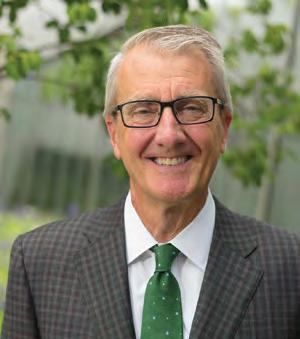
THE ROBERT LARNER, M.D. COLLEGE OF MEDICINE AT THE UNIVERSITY OF VERMONT FALL 2022 | PUBLISHED OCTOBER 2022
CONTENTS
The Founder
Larner Today: The Facts
NEWS
The newest department, latest leadership, and more.
a look at the milestones of the last 200 years.
OBJECT LESSONS
Research Beginnings
The Vermont Connection to Early Clinical Investigation.
The Namesake
Robert Larner, M.D.’42 never forgot his roots.
Pride of Place
culture of acceptance and affirmation.
FEATURES
Where it Happens
From a single brick structure, the College’s presence has spread across the campus, and beyond.
Making a Physician
The prescription for a successful curriculum has seen many revisions.
The Forerunners
UVM’s first African American medical students.
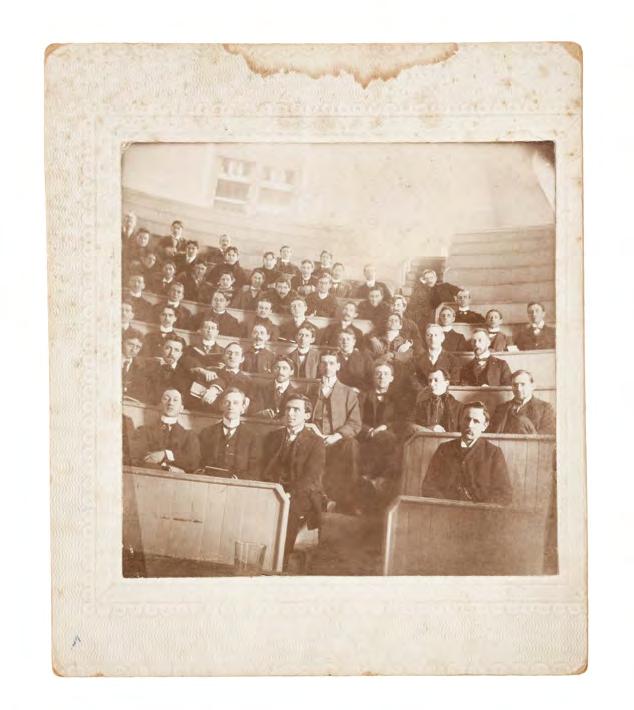
Times of Crisis
institution that reaches the 200-year mark must have its share of struggle along with success.
The First Women
In the 1920s, a few pioneers overcame obstacles built by tradition, bureaucracy, and their fellow students.
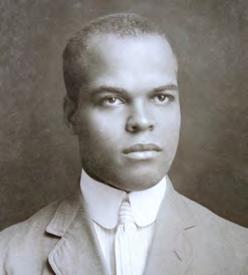
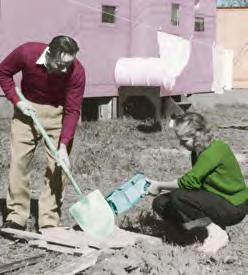
Unfolding a Home
For returning World War II veterans, barracks life shifted to “trailer camp” during medical school.
Probing Oxygen’s Mysteries
UVM’s newest University Distinguished Professor, Yvonne Janssen-Heininger, Ph.D., studies adverse reactions that can take our breath away.
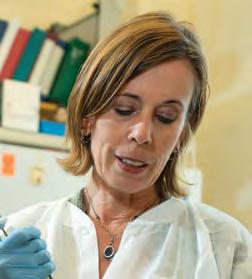
HALL A
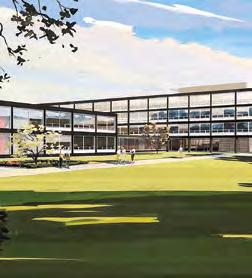
notes and news, and a look at distinguished alumni of the past and present.
decades of stories from this magazine.
UVM LARNER COLLEGE OF MEDICINE 1 On the cover: Tickets to medical lectures at the College from the 1860s and 1880s VERMONT MEDICINE | FALL 2022 SPECIAL BICENTENNIAL ISSUE 22 16 26 4238
16
22
26
30
Any
32
38
42
50 Class
64 Six
20
36
48
A
6
Plus
2
4

VERMONT MEDICINE FALL 20222
The Founder
DR. JOHN POMEROY
Just inside the gates of Burlington’s Elmwood Cemetery lies the most prominent of its memorials, a carved granite block that marks the resting place of Dr. John Pomeroy and his family members. But in a way, a larger monument to the doctor lies a mile up the hill overlooking the city: the College of Medicine that his effort, more than any other, brought into being.

Pomeroy, a Revolutionary War veteran, moved from Connecticut to Cambridge in 1787, in what was then the Republic of Vermont. In 1792, having married his wife, Mary, he moved to Burlington, and his thriving practice enabled him to build the substantial brick house—said to be the first brick house in the town—that stands to this day on lower Battery Street.

The doctor was an early trustee of the fledgling University of Vermont. In 1804 Pomeroy was the first medical faculty appointee at UVM, as a lecturer in “anatomy and chirurgery.” Around then he began taking in apprentices at his home office, then the predominate pathway to becoming a physician. Pomeroy’s skills were legendary: according to one notable account, he performed a tracheotomy aboard a canal boat on Lake Champlain using the hollow tube of a goose quill as a cannula.
In the years after the War of 1812, Pomeroy began the first formal medical lectures at the university, and in 1814 he was one of the three founders of what is now the Vermont Medical Society. In 1822 Pomeroy was part of a group, along with the prominent medical educator, Nathan Smith, who organized the first official series of lectures at what would later be called the College of Medicine. But Pomeroy’s name, for reasons that are still unknown, would never formally appear on the “Medical Department” faculty rolls. He continued to practice medicine in Burlington until 1834, ten years before his death. His name is carried today by Pomeroy Hall, the cupolatopped building just south of the UVM Green, that in 1829 became the first dedicated home of the College of Medicine.
UVM LARNER COLLEGE OF MEDICINE 3
Dr. John Pomeroy’s gravestone at Burlington’s Elmwood Cemetery and his home (above, right) in Burlington.
7TH OLDEST MEDICAL SCHOOL IN THE NATION
by Burlington physician John Pomeroy, and early medical education advocate Nathan Smith, the College awarded its first M.D.s in August of 1823. In September 2016 the College was named after philanthropist and Class of 1942 alumnus Robert Larner, M.D., becoming the first medical school in the nation named for one of its
CLASS OF 2026
RESEARCH
funds
CLASS OF 2022 MATCH RESULTS
University
University of
Center, Danbury
Brown University,
Clinic, University of Chicago,
University
DEPARTMENTS
newest clinical department, the Department of
Medicine, was established
1, 2022.
2022
funded
grants at UVM were
Larner faculty
FACILITIES/ PHYSICAL
VERMONT MEDICINE FALL 20224 LARNER TODAY: THE FACTS STUDENT BODY/ FACULTY/STAFF ALUMNI 483 Me dical students 300+ Graduate students 42 Postdoctoral students 910 Salarie d Faculty 893 Residents 632 Fellows 480 Staff members 5,600+ Living alumni of the College 50% Number of living alumni who have made gifts to the College 44.4% Approximate number practicing in New England 33% Approximate percentage of Vermont physicians educated or trained at the Larner College of Medicine and/or UVM Medical Center
Larner 2022 graduates went on to residencies across the nation, including Yale-New Haven Hospital, Stanford
Programs,
Vermont Medical
Hospital,
the Cleveland
Duke
Medical Center, and UCLA Medical Center. 114 Larner Class of 2022 graduates matched 63 Institutions were matched to 14 Matched to Vermont sites 53 Graduates matched in primary care areas
PLANT 615,500 Total Gross Square Feet (GSF) 196,000 GSF Given Building 110,000 GSF He alth Science Research Facility 31,000 GSF Cour tyard at Given 44,000 GSF Me dical Education Center 70,000 GSF Stafford Hall 72,000 GSF Colchester Research Facility 30,000 GSF DeGo esbriand 62,500 GSF Firestone Medical Research Building
The College received more than nine thousand applications for 124 positions in the Class of 2026, who began their first year in August 2022. 3.70 Median undergraduate GPA 29% Vermonters 61% Identify as female 23% Underrepresented in Medicine 20% Identify as coming from a lower socio-economic background
Founded
graduates.
Larner’s
Emergency
July
4 Basic Science 12 Clinical
$117.9 million in research
awarded in Fiscal Year 2022 400 Research awards 509 Projects supported 50.4% of
federally
research
awarded to

UVM LARNER COLLEGE OF MEDICINE 5
Department of Emergency Medicine Chair Ramsey Herrington, M.D.
Emergency Medicine Becomes Newest Department


July 1 was the beginning of a new fiscal year at the University, and with it came the official formation of a new department, the Department of Emergency Medicine—the first new department at the Larner College of Medicine in a decade— and the appointment of Ramsey Herrington, M.D., as the department’s inaugural chair.
Emergency Medicine had its tentative beginnings at UVM in the 1950 and 1960s and has functioned for more than 50 years as a division of the Department of Surgery. Until this summer the Larner College of Medicine was the only medical school in New England, and one of only eight allopathic medical schools in the country, without an academic Department of Emergency Medicine. This May, the University’s Board of Trustees considered Dean Page’s request to form a distinct department, which had the overwhelming approval of Larner faculty, and agreed with the need to take this step.
“Besides aligning Larner with the national standard, the formation of the new Depart ment of Emergency Medicine puts us in a strong position to build on the progress made in this area at UVM,” said Page. Over the last five years, emergency medicine has doubled its faculty from 19 to 40, built a nationally competitive residency program, positioned academically focused fac ulty at affiliate hospitals across the University of Vermont Health Network, and greatly expanded funded research efforts.
“This progress has been led most recently by
Ramsey Herrington, M.D., and I am pleased that Dr. Herrington will continue his leadership as the inaugural chair of the new department,” said Page. An associate professor of surgery, Dr. Herrington joined UVM in 2006. In 2021 he was appointed the first Emergency Medicine Health Care Service leader, and he has served as division chief of emergency medicine since 2017. In addition, he serves as Specialty Council Chair, Emergency Medicine, for the UVM Health Network. Under his leadership, the UVM Health Network successfully launched its first accredited residency in emergency medicine, and he led the recruitment of numerous high-quality faculty members.
Dr. Herrington is involved in ongoing research in numerous areas in his field and has published in such journals as the Annals of Emergency Medicine, Respiratory Care, and the Journal of the American College of Emergency Physicians Open. He has shown a strong commitment to teaching, having to date guided approximately 50 Larner medical students into Emergency Medicine residencies and careers, both here in Vermont and throughout the nation. Among the awards he has received are the 2011 H. Gordon Page Clinician of the Year Award, the 2016 John H. Davis Service Award, and the 2017 University of Vermont Medical Center Living the Leadership Philosophy Award. Dr. Herrington’s longstanding commitment to advancing equity in his division was recognized with the College’s 2020 Gender Equity Champion Award.
1804
John Pomeroy begins teaching medicine to students in his Burlington home.
1822
Nathan Smith delivers first formal lecture at UVM “Medical Department.”
1829
Completion of the Medical Department’s first home, now known as Pomeroy Hall.
1837
The economic “Panic of 1837” contributes to the suspension of medical instruction.
1854 Medical classes resume, under first official dean, Samuel Thayer.
1884
Philanthropist John Purple Howard donates an expanded second home for the Medical Department.
1885
First African American UVM medical student, Thomas James Davis, graduates.
1894
Charles Caverly, M.D.1881, describes the first U.S. polio epidemic, in Rutland County.
1899 The University assumes administrative control of what is now the College of Medicine.
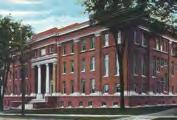
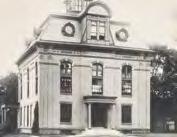
1903 The College Building is destroyed by fire on December 3.
1905
The College’s third home, today known as Dewey Hall, is completed.
VERMONT MEDICINE FALL 20226
NEWS
MILESTONES
TWO NEW CHAIRS NAMED
AFTER EXTENSIVE NATIONAL SEARCHES, the Larner College of Medicine welcomed two new department chairs this summer.
Rebecca A. Aslakson, M.D., Ph.D., joined the College in September as chair of the Department of Anesthesiology. Dr. Aslakson, who received her medical degree from Harvard Medical School/ Massachusetts Institute of Technology, comes to UVM from the Stanford University School of Medicine, where she was professor in both the Department of Anesthesiology, Perioperative, and Pain Medicine and the Department of Primary Care and Population Health in its Palliative Care Section. In 2019, she was appointed division chief of Adult Critical Care Medicine in the Department of Anesthesiology, Perioperative, and Pain Medicine at Stanford. She was also a member of both the Stanford Center for Biomedical Ethics and the Stanford Cancer Center.
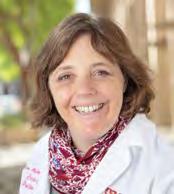
Robert Althoff, M.D., Ph.D., associate professor of psychiatry at UVM, was appointed chair of the Department of Psychiatry and Health Care Service Leader for Psychiatry, effective August 1. Dr. Althoff served as interim chair of the department since October 1, 2021, succeeding Dr. Robert Pierattini.
Dr. Althoff, received his M.D. from the University of Illinois College of Medicine, and his Ph.D. from the University of Illinois. He has been a member of the UVM faculty and UVMHN Medical Group since 2006, and since 2017 has served as medical director for psychiatry at Champlain Valley Physicians Hospital (CVPH), and division chief, Adirondack Division, in the Depart ment of Psychiatry. He has also been involved in clinical care across the UVM Health Network. From 2014 to 2017 he was executive vice president of UVM’s Research Center for Children, Youth and Families.
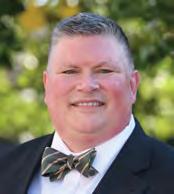
UVM Health Network Names Eappen Next President and CEO
The University of Vermont Health Network named Sunil “Sunny” Eappen, M.D., M.B.A., as the health system’s next president and chief executive officer, following a national search. Eappen, who comes from Boston’s Brigham and Women’s Hospital, will lead the organization forward in the next phase of its evolution into a more integrated and equitable health system. He will be responsible for oversight of all operations, including the flagship academic medical center, five community hospitals, children’s hospital, a multi-specialty physician group, and home health and hospice agency. His appointment is effective November 28.
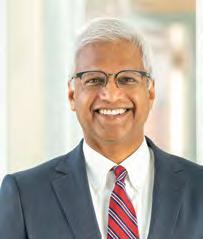
“The UVM Health Network is a model for how we can provide and preserve high-quality health care in our communities, while innovating and educating through academic medicine,” said Eappen. “I am honored and humbled by the opportunity to work alongside, learn from and support thousands of dedicated providers and staff across Vermont and Northern New York, and to deliver on the promise of the Network. Together, we will address our challenges and work to pro vide expert, equitable, value-based health care for our patients and communities.”
Eappen most recently served as chief medical officer and senior vice president for medical affairs for Brigham and Women’s and as an associate professor of anesthesia at Harvard Medical School. He was named interim president of Brigham and Women’s from March 2021 to December 2021, when a permanent candidate was selected. He is the author of numerous published articles and a national speaker on topics including optimizing OR efficiency, surgical checklist implementation and change management.
He succeeds John R. Brumsted, M.D., who is retiring after leading the health system for more than 10 years.
“I’m incredibly pleased with the result of the search, and I’m dedicated to ensuring a smooth leadership transition for our health system,” said Brumsted.

SENATOR AND VA SECRETARY VISIT LARNER
UVM LARNER COLLEGE OF MEDICINE 7
U.S. Senator Bernie Sanders (I-Vt.), former chair and current member of the Senate Veterans Affairs Committee, and U.S. Department of Veterans Affairs (VA) Secretary Denis McDonough held a special Town Hall with medical students at the College in April. Their discussion featured remarks and a Q&A session that focused on career opportunities for physicians at the VA.
NEWS
UPP participants working in the Clinical Simulation Laboratory.
“UPP” Program Clarifies Journey for Pre-Med Students

With the goal of one day becoming a physician, Kiana Heredia started her undergraduate degree at Mount Holyoke College as a pre-medical student. Faced with a course load of classes such as organic chemistry, inorganic chemistry, and physics, Here dia says she began to second-guess the gut feeling that she belonged in the medical field.
“An Intro to Physics course was my first taste of what it meant to be a pre-med student and as a newly minted first-year undergraduate college student, it was nothing like I expected,” wrote Heredia in a March 2022 post for the UVM Larner Med Blog. “I remember thinking to myself, ‘This can’t be something I want to do for the rest of my life—kinetic energy? magnetic fields? What am I doing here?’” she recalled. In addition, she said, “This Intro to Physics course shaped my first academic relationship to medicine and with no family members or friends in the healthcare field, I was convinced that these pre-med requirements and medicine were synonymous, in meaning and experience, without any room for expansion.”
Heredia graduated with a degree in psychology, but it wasn’t until a few years later, after volunteer ing at a geriatric facility and fertility clinic in Spain, that she rediscovered her love of medicine and began her path back to a career as a physician.
Now Heredia is a Class of 2024 Larner medical student. She recently helped Assistant Professor of Pediatrics L.E. Faricy, M.D., create the URiM Pathway to Pediatrics (UPP) program to assist others who may encounter the doubts she
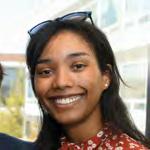
experienced during her undergraduate years. The UPP program originated from a grant proposal Faricy and Heredia developed with Nicole Obongo ’24, Annaliese Lapides ‘24 and Mialovena Exume ’24, for American Academy of Pediatrics funding to support events aimed at increasing workforce diversity and supporting students historically underrepresented in medicine (URiM.)
When the grant proposal was not accepted, Faricy approached her chair, Lewis First, M.D., to see if the Department of Pediatrics would be interested in funding the program. Not only did First agree to funding the program, he also became an integral part of the event.
In April, the inaugural cohort of 14 participants including undergraduate pre-med college students from UVM, SUNY-Plattsburgh, Community College of Vermont, Saint Michael’s College, Middlebury College, and Castleton University, along with two students from Burlington High School, began the day-long event with hands-on group skills sessions, including a “Clinical Mystery Case” session led by First, and interactive simulation stations to practice colonoscopy and laparoscopic skills, care for a newborn just after delivery, learn pointof-care ultrasound techniques, treat a child in respiratory distress, understand vital signs, and perform lumbar punctures.
Like most participants, Ahmed Alrai, a UVM rising senior, found the event gave him the focus and encouragement he needed. “For as long as I can remember, I have wanted to be a physician and the UPP program just gave me more motivation to fulfill my dreams,” Alrai said.
1906 The UVM Medical Alumni Association is founded.
1910
The Flexner Report sparks reform at the College.
1924 Dorothy Lang is the first female UVM M.D. recipient.
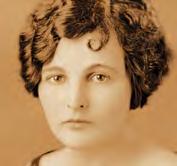
1938 Faculty committee administers College for two years and initiates reforms.
1940 Dallas Boushey joins the Anatomy Department as janitor and lab assistant. He would go on to spend 50 years at the College, eventually becoming an anatomy instructor and receiving an honorary Doctor of Science degree.
1959 Moses Alfred Haynes, M.D., becomes the first African American faculty member, but leaves after only a short time.
1962 Jackson J.W. Clemmons, Ph.D., M.D., now emeritus professor of pathology, joins the College as the second African American faculty member. He will teach and conduct research for more than 30 years.
1967 The “New Curriculum” promotes early clinical experience.
1968 The College moves “up the hill” to the Given Building.
1974 UVM Cancer Center founded.
1980 Maine Medical Center affiliation begins.
VERMONT MEDICINE FALL 20228
READ MORE ABOUT THE UPP EXPERIENCE AT MED.UVM.EDU/VTMEDICINE/WEB-EXTRAS
MILESTONESNEWS
LARNER ANNOUNCES TWO NEW ASSOCIATE DEANS
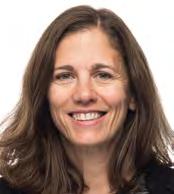
IN MAY, LEILA AMIRI, PH.D., WAS NAMED Larner’s next associate dean for admissions. Dr. Amiri comes to the College from the University of Illinois College of Medicine, where she was associate dean for admissions and recruitment. Previously, she was director of admissions and financial aid for the University of Chicago Pritzker School of Medi cine. She holds a Ph.D. from North central University, and M.A. and B.S. degrees from the University of South Florida.
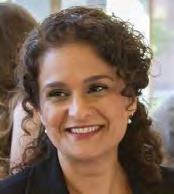
Also in May, Karen George, M.D., M.P.H., was named Larner’s new associate dean for students. George was previously clinical associate professor of obstetrics and gynecology at George Washington University and chair of the Council for Residency Education in Obstetrics and Gynecology (CREOG) of the American College of Obstetricians and Gynecologists.
George served as director of the Obstetrics and Gynecology Residency Program at Dartmouth-Hitchcock Medical Center/Geisel School of Medicine for 17 years and is a course advisor and co-director of the Fourth Year Transition to Residency Course at George Washington University College of Medicine. She also serves as senior fellow of women’s health policy at the Institute for Medicaid Innovation. George received a B.S. degree from Bates College, M.D. from Ohio State University College of Medicine, and an M.P.H. from the Dartmouth Institute for Health Policy and Clinical Practice.
Leila Amiri, Ph.D. (top) and Karen George, M.D., M.P.H.
Latest Frymoyer Scholar Programs Announced
This summer, Larner Teaching Academy Director Kathryn Huggett, Ph.D., and the Frymoyer Scholars Program Review Committee announced the names and respective investigators aligned with each of three faculty group projects selected to receive 2022 Frymoyer Scholars funding.
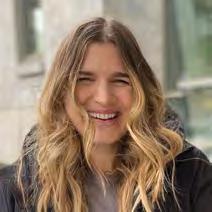
Supported by a philanthropic fund—the John W. and Nan P. Frymoyer Fund for Medical Education—the Frymoyer Scholars Program recognizes outstanding medical education and promotes teaching that emphasizes the art of patient care. This fund supports interprofessional education and practice and provides funding for physicians and nurses who are actively engaged in teaching UVM medical and nursing students and who embody the best qualities of the clinician-teacher.
The Frymoyer Fund pays tribute to the deep legacy of the late John Frymoyer, M.D., dean of UVM’s College of Medicine from 1991 to 1999, and his late wife Nan, a community health nurse who had a strong interest in patient advocacy. The fund was established in 2000 through generous donations from J. Warren and Lois McClure, the Frymoyers, and many community donors, as well as the Larner College of Medicine Alumni Association.

The 2022 funded projects focus on improving newborn resuscitation in community hospital settings; on improving interprofessional collaboration in medical education; and on developing an interdisciplinary gender affirming care model in the emergency department.
Read more about the Frymoyer Scholars Program at: med.uvm.edu/teachingacademy/frymoyer
QUOTED
– Class of ’24 medical student Finlay Pilcher, commenting on her New Hampshire/ Vermont Schweitzer Fellowship project that aimed to improve HPV vaccination in Lamoille County, Vt., to protect adolescents from several types of cancer. For this work Pilcher was awarded a 2022 Excellence in Public Health Award from the U.S. Public Health Service (USPHS) Physician Professional Advisory Committee.
UVM LARNER COLLEGE OF MEDICINE 9
“I have come to appreciate that there are often more metrics of success than the ones we plan to measure. Sometimes, the intangibles are just as important.”
The late John W. Frymoyer, M.D., and Nan Frymoyer
READ FINLAY PILCHER’S BLOG ABOUT HER WORK AT MED.UVM.EDU/VTMEDICINE/WEB-EXTRAS
NEWS
NOTABLE
PARSONS LEAVES TO LEAD AAIM; DIXON BECOMES INTERIM CHAIR
Polly Parsons, M.D., who for 16 years chaired the Larner Department of Medicine, became president and CEO of the Alliance for Academic Internal Medicine (AAIM) on October 1. AAIM has more than 11,000 faculty and administrator members in departments of internal medicine in medical schools and teaching hospitals. Taking on the position of interim chair of the department is Professor of Medicine Anne Dixon, M.A., BM BCh. Dixon, who joined the UVM faculty in 2001, has served as director of the Vermont Lung Center since 2019. In addition, she is chief of the Division of Pulmonary and Critical Care Medicine and an attending physician at the UVM Medical Center. In April of this year the UVM Graduate College named her as one of four 2022-2023 University Scholars.
CARR ELECTED AAAS FELLOW
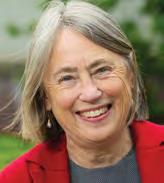
The American Association for the Advancement of Science (AAAS)—the world’s largest general scientific society and publisher of the Science family of journals, has honored Frances Carr, Ph.D., professor of pharmacology and UVM Cancer Center member, with election as a AAAS Fellow, among the most distinctive honors within the scientific community. AAAS recognized Carr “for distinguished contributions to the field of thyroid hormone biology and pathology, and for exemplary leadership positions in two universities and major contributions to science policy for U.S. government agencies.”
SILVEIRA HONORED FOR TEACHING EXCELLENCE
Jay Silveira, Ph.D., assistant professor of biochemistry, was selected to receive a 2022 UVM Kroepsch-Maurice Excellence in Teaching Award, which recognizes faculty for excellent undergraduate instruction, innovation in teaching methods and ability to motivate and challenge students. Silveira teaches undergraduate courses in biochemistry fundamentals, explaining the molecular mechanisms behind how bodies function in both healthy and disease states. In addition, he serves as faculty advisor to the UVM Biochemistry Society undergraduate club.
KOCH NAMED DIRECTOR OF UVM CLINICAL SIMULATION LABORATORY
Assistant Professor of Emergen cy Medicine and Larner alum
Nick Koch, M.D.’14 has been named clinical director of the UVM Clinical Simulation Laboratory (CSL). Koch will be the laboratory’s fourth director, replacing former Associate Professor of Anesthesiology Vincent Miller, M.D., who served in the position for five years. The CSL is an important training ground for both burgeoning and current healthcare professionals. It serves as a hub for hands-on, interactive work with standardized patients, manikins, and simulated clinical cases for students studying at Larner and CNHS as well as professionals from UVMMC, the UVM Health Network, and beyond.
MARILYN J. CIPOLLA, PH.D. NAMED CHAIR OF ELECTRICAL AND BIOMEDICAL ENGINEERING
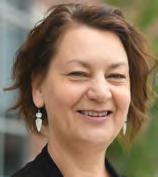
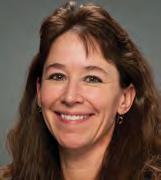
Marilyn J. Cipolla, Ph.D., a member of the Larner faculty for nearly 20 years, has been named chair of the Department of Electrical and Biomedical Engineering in UVM’s College of Engineering and Mathematical Sciences (CEMS). Cipolla began her career at UVM earning her B.S. in Electrical Engineering from CEMS in 1988, and subsequently earned both her M.S. and Ph.D. at UVM in Cell and Molecular Biology. Cipolla is a professor in the Department of Neurological Sciences with joint appointments in Obstetrics, Gynecology, and Reproductive Sciences and in Pharmacology.
WILCOX SELECTED FOR ELAM FELLOWSHIP
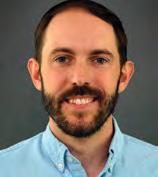
Rebecca Wilcox, M.D., professor of pathology and laboratory medicine and associate dean for faculty affair, has been selected as a member of the 2022-2023 class of fellows participating in the Hedwig van Ameringen Executive Leadership in Academic Medicine® (ELAM) Program at Drexel University College of Medicine. Established in 1995, ELAM is the nation’s only in-depth program focused on preparing senior women faculty at schools of medicine, dentistry, and public health for institutional leadership positions. Wilcox is one of 72 new ELAM fellows.
1985 Pediatrician Carol Phillips, M.D., becomes first female department chair at the College.
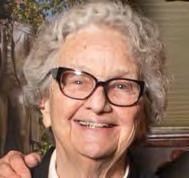
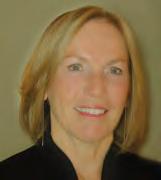
2001
Health Science Research Facility opens.
2003
The Vermont Integrated Curriculum debuts.
2005 Medical Education Pavilion and new Dana Medical Library opens.
2009 Courtyard at Given “building within a building” opens.
2015
The College’s Teaching Academy is founded.
2016 The College is renamed to honor the support of philanthropist and alumnus Robert Larner, M.D.’42.
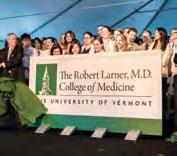
2019 University Distinguished Professor Mark Nelson, Ph.D., elected to National Academy of Sciences.
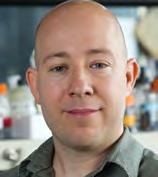
2020 Larner faculty, students and staff pivot in myriad ways during the pandemic.
2021 Formal launch of the Connecticut Branch Campus with Nuvance Health at Danbury and Norwalk Hospitals.
VERMONT MEDICINE FALL 202210
MILESTONESNEWS
Integrating Mental Health into Pediatric Primary Care
When she joined UVM Children’s Hospital Pediatric Primary Care practice in the 1990s, Associate Professor Catherine Rude, M.D., struggled to support her patients with mental health concerns. The practice did not include psychologists, psychiatrists and social workers, and connecting children to off-site specialists took great effort, Rude said.
“It was challenging to get psychiatric care for children. Wait times were extremely long and the paperwork hurdles that patients had to go through to see a mental health clinician were insurmountable for many families,” said Rude.
UVM Pediatric Primary Care is removing barriers to mental health care with an evidencebased Primary Care Mental Health Integration program, piloted with support from the UVM Health Network. Stan Weinberger, M.D., associate professor of pediatrics and pediatric primary care division chief, Rude, Michelle Streeter, R.N., and Logan Hegg, Psy.D., clinical assistant professor of psychiatry and pediatrics, lead the effort in partnership with Maureen Leahy, M.Ed., director of psychiatry and neurology healthcare services, UVM Medical Group, Sara Pawlowski, M.D., primary care mental health integration division chief and assistant professor of psychiatry, Clara Keegan, M.D., associate professor of family medicine, and Kerry Stanley, LICSW, lead behavioral health care manager.
This team-based approach amplifies UVM Children’s Hospital’s comprehensive mental health services by integrating psychology, social work and psychiatry with primary care. Within this model, primary care clinicians and mental health specialists coordinate each patient’s care with in-person huddles, information-sharing and collaborative care that responds to individual patient preferences.
“The goal is to increase access in a timely and thoughtful process, providing seamless whole-person care as a team,” said Hegg. “By integrating mental and behavioral health providers with complementary skills, we are building support for kids, families and pediatric clinician colleagues.”
The primary care setting can make a large impact in detecting and managing mental health issues, especially among underserved populations, Hegg said. Opportunities for routine mental health screening, assessment and preventative intervention give entrée to people who traditionally lack access, including families with lower socio-economic means, New Americans, and gender expansive youth. Providing youth with a place to work on mental health concerns builds on their longitudinal relationship with a primary care clinician.
Integrating mental health and primary care meets patients and providers where they are, the same day a patient presents in clinic. Struggling patients and families receive care in the exam rooms along with wellness check-ups and immunizations, decreasing stigma and disparities. Providers appreciate the responsive support.
“It’s been so helpful to have a comprehensive mental health team integrated into primary care. Now these specialists are on staff in the practice and patients can make an appointment with them in the office,” said Rude.
Added Hegg, “If we can get ahead of the curve, we won’t be scrambling as much with emergency department visits and crisis evaluations. It’s been a real game-changer for the 7,500 kids and families who entrust us for their primary care.”
The primary care mental health integration team supports training multidisciplinary providers to implement and expand this model of care, developing clinicians who appreciate medical-psychiatric comorbidity and the importance of team-based care in a primary care medical home. While the pilot rolled out in a few primary care clinics, increased mental health care staffing will spread across all 37 UVM Medical Center primary care sites over the next few years.
“Our plan is to bring this model to all UVM Health Network primary care clinics,” said Hegg. “We want this to be the standard to how primary care is delivered in our region.”
UVM LARNER COLLEGE OF MEDICINE 11
“Now these specialists are on staff in the practice and patients can make an appointment with them in the office.”
– C ATHERINE RUDE, M.D.
NEWS
Back in Person, Back in Style
2022
The Class of 2022’s medical school journey turned upside-down in March 2020 when the COVID-19 pandemic forced a stay-at-home order, a pivot to remote learning, and put their clinical training on hold.
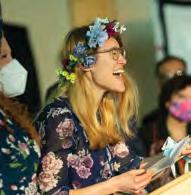
Match Day—celebrated on the same day at medical schools across the country—marks a critical moment in the lives of soon-to-be M.D. recipients—the moment when they learn where they’ll spend the next three to seven years for specialty training. After having the coronavirus control so much of their lives, the senior students had to put one more thing in the hands of an outside entity—the National Resident Matching Program, and its computerized algorithm that aligns the preferences of applicants with the preferences of residency program directors, in
order to produce the best possible outcome for filling training positions at U.S. teaching hospitals.
UVM’s traditional in-person event—set aside in 2020 and 2021 due to COVID-19 restrictions— features a faculty physician bagpiper leading the senior class into the venue, mascot “Dr. Moo,” a crowd of supporters, cheers, tears, smiles and balloons. There is even a Match Day theme (floral this year) selected by each graduating class.

VERMONT MEDICINE FALL 202212 Match Day 2022 was celebrated at the UVM Davis Center. CLASS OF 2022 MATCH RESULTS 14 IN VERMONT 53 TO PRIMARY CARE 63 INSTITUTIONS 114 STUDENTS MATCHED
MATCH DAY
READ MORE ABOUT MATCH DAY: MED.UVM.EDU/VTMEDICINE/WEB-EXTRAS
NEWS
ANESTHESIOLOGY
Sarah Clark
Faith Wilson Genereux
LARNER
University of Vermont Medical Center
Vanderbilt University Medical Center
Ryan Harned University of Connecticut School of Medicine
Francis Mtuke........................... Virginia Mason Medical Center (Seattle)
Anna Quinlan University of Vermont Medical Center
Irene Sue
DERMATOLOGY
University of Iowa Hospitals and Clinics
Seneca Hutson Mayo Clinic (Minn.)
DIAGNOSTIC RADIOLOGY
Sameer Alidina Rochester General Hospital
Christian Brooks Montefiore Medical Center/Einstein
EMERGENCY MEDICINE
Patrick Clarke University of California San Francisco
Marlijne Cook
University of Utah Health
Carolyn Geraci Hennepin County Medical Center (Minn.)
Prasanna Kumar
Brown University/Rhode Island Hospital
Tierra Lynch University of Utah Health
Taylor Marquis
Brown University/Rhode Island Hospital
Elena Martel Stanford Health Care
Carley Mulligan
University of Utah Health
Kaitlyn Peper Albany Medical Center
Maha Saleem
Yale-New Haven Hospital
Nikkole Turgeon Boston University Medical Center
Jenna Wells
FAMILY MEDICINE/RURAL HEALTH
Chan
OBSTETRICS & GYNECOLOGY
Gia Eapen
Lauren Gernon
Case Western/MetroHealth Medical Center
University of Vermont Medical Center
Kalin Gregory-Davis Brown University/Women & Infants Hospital
Alexandra Kuzma
Crozer-Chester Medical Center (Upland, Pa.)
Zeynep Tek Danbury Hospital
OPHTHALMOLOGY
Delaney Curran
Aram Garewal
Jeremy Greenberg
Ian McClain
ORTHOPAEDIC SURGERY
Michael Barnum
UMass Chan Medical School
SUNY Downstate Medical Center (Brooklyn, N.Y.)
SUNY Stony Brook
University of Colorado School of Medicine
Benjamin Kagan . . . . . . . . . . . . . . . . . . . . . . . . .
John O’Keefe
Orlando Health (Fla.)
.University of Vermont Medical Center
Prisma Health-University of South Carolina
Alexa Pius Stanford Health Care
Samuel Raszka
Peter Twining
OTOLARYNGOLOGY
Cedars-Sinai Med Center (Los Angeles)
SUNY Downstate Medical Center (Brooklyn, N.Y.)
Kyle Leonard Henry Ford Hospital (Detroit)
Nicole Wershoven
PATHOLOGY
Baystate
Sheridan Finnie University of North Carolina Hospitals
FAMILY MEDICINE
Mary Ann Kelly Barnum
AdventHealth Florida
Elizabeth Baumgartner Concord Hospital (N.H.)
Karla Brandao-Viruet
Boston University Medical Center
Olivia Cooper Mountain AHEC Asheville (N.C.)
Emma Hall Family Medicine Res of Idaho, Boise
Malla Keefe Family Medicine Res of Idaho, Boise
Ray Mak Sutter Medical Center of Santa Rosa (Calif.)
Michelle Oberding Maine Medical Center
Myrna Sanchez-Grew Long Beach Memorial Medical Center (Calif.)
Lauren Struck Maine-Dartmouth Family Medicine
Jacob Weiss University of Colorado – Denver
GENERAL SURGERY
Megan Boyer University of Rochester/Strong Memorial
Emily Eakin . . . . . . . . . . . . . . . . . . . . . . . .
University Medical Center
Collin Montgomery University of Iowa Hospitals and Clinics
Emily Straley University of Utah Health
INTERNAL MEDICINE
Amelia Anderson
University of Utah Health
Richard Brach UCLA Medical Center
Sara Brennan
University of Vermont Medical Center
Francesca Garofalo University of Wisconsin Hospital and Clinics (Madison)
Lizzi Hahn
Cleveland Clinic Foundation
Erick MacLean University of Utah Health
Rose Martin
UMass Chan Medical School
Cinduja Nathan Loma Linda University (Calif.)
Ashleigh Peterson
Dartmouth-Hitchcock Medical Center
Lauren Schlussel Cedars-Sinai Med Center (Los Angeles)
Anya Srikureja
Mount Sinai Hospital (N.Y.)
Michael Tabet University of Iowa Hospitals and Clinics
Angela Troia
Georgetown University Hospital (D.C.)
Allison Tzeng Temple University Hospital
INTERVENTIONAL RADIOLOGY
Adrian Berg
MEDICINE-PEDIATRICS
University School of Medicine
Sylvia Lane University of Maryland Medical Center
NEUROLOGY
Kelly Chan University of California Davis Medical Center
Leah Miller University of Utah Health
Rachel Madhur Yale-New Haven Hospital
Adam Morehead University of Vermont Medical Center
Sabrina Wirth University of Vermont Medical Center
University of Colorado – Denver
Garrett Chan UC San Francisco
Catherine Gereg
Yale-New Haven Hospital
Dore Grier Guptil University of Vermont Medical Center
Mohammed Wali
PEDIATRICS
Abigail Belser
Beth Israel Deaconess Medical Center (Boston, Mass.)
Boston Children’s Hospital
Julia Clemens University of Wisconsin Hospital and Clinics (Madison)
Alim Esemenli N.Y. Presbyterian-Weill Cornell Medical Center
Jennifer Holland Children’s Hospital of Philadelphia
Kelly MacPherson
Brown University/Rhode Island Hospital
Colby McGinn UMass Chan Medical School
Adessa Morano University of Vermont Medical Center
Kathleen O’Hara University of North Carolina Hospitals (Chapel Hill)
Melanie Parziale . . . . . . . . . . . . . . . . . . . . . . . . . .
University of Chicago Medical Center
Megan Prue University of Vermont Medical Center
Phuong Tran University of Colorado – Denver
PHYSICAL MEDICINE & REHABILITATION
Claudia Russell Thomas Jefferson University
PRELIMINARY SURGERY
Emma Levine
Vanderbilt University Medical Center
Shayan McGee Dartmouth-Hitchcock Medical Center
PRIMARY MEDICINE
Alexander Braun
Boston University Medical Center
Kayla Sturtevant University of Vermont Medical Center
PSYCHIATRY
Matthew Brandt
University of Maryland Medical Center
Jose Calderon Yale-New Haven Hospital
Noorin Damji Duke University Medical Center
Adam Fakhri
Emory University
Rachel Harrison University of North Carolina Hospitals (Chapel Hill)
Jordan Munger University of Washington Boise (Idaho)
Alice Peng UMass Chan – Baystate
RADIATION ONCOLOGY
Luke Higgins
THORACIC SURGERY
Lauren Bougioukas
VASCULAR SURGERY
Jugerta Istrefi
University of Michigan Hospitals – Ann Arbor
Zucker School of Medicine – Northwell (N.Y.)
Montefiore Medical Center/Einstein
UVM LARNER COLLEGE OF MEDICINE 13
COLLEGE OF MEDICINE CLASS OF 2022 RESIDENCY MATCH LIST
....................
...............................
.......................................
.......................
........................
......................................
........................................
............................................ UMass
–
. . . . . . . . . .Boston
....................................
.............................
........................................
.......................................
.........................
............................... ISMMS
.................... MedStar
............................... Emory
...........................
...................
..............................
.....................................
..........
............................
..............................
......................
A Day of Celebration and Commitment
IN-PERSON COMMENCEMENT RETURNS TO IRA ALLEN CHAPEL.
On Sunday, May 22, 106 members of the medical Class of 2022 strode across the stage at Ira Allen Chapel to receive their hoods and M.D. diplomas – the first such fully in-person ceremony since the onset of the COVID-19 pandemic in March 2020.

Commencement speakers, including Vermont Senator Bernie Sanders, acknowledged the hurdles these graduates had endured due to the pandemic and the important impact they were poised to make to ensure a better future for society.
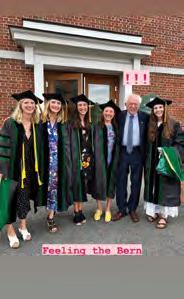
In his welcome remarks, Dean Richard L. Page said, “Hard work and long hours come with medical education, but nobody predicted you would become a doctor amid the greatest worldwide health crisis in a century.” He added that, “You, the Class of 2022, are the clearest indicators … of better times ahead … You’ve gained incomparable experience in helping to fight a pandemic … you have shown commitment, compassion and professionalism.”
UVM Medical Center Chief Medical Officer Isabelle Desjardins, M.D., encouraged the new doctors to stay humble and keep their patients at the center of all of their decisions. “You are entering medicine at a time when the amount of new knowledge to acquire far exceeds anyone’s capacity to retain it,” she said. “You will have to remain curious, constantly challenging yourself to keep your mind open. There will be moments … when you don’t
VERMONT MEDICINE FALL 202214
READ MORE ABOUT COMMENCEMENT: MED.UVM.EDU/VTMEDICINE/WEB-EXTRAS
know what else to do or to say … these are the moments when integrity, and humanity, will matter most.”
While he opened by congratulating the medical Class of 2022 on their “incredible efforts to be where you are today,” Senator Sanders asked the graduates for something “above and beyond your skills as physicians,” in his capacity as chair of the U.S. Senate Subcommittee on Primary Health and Retirement Security. He told them that, “The overall healthcare system in which you all will be practicing is a system which is dysfunctional, extraordinarily waste ful and expensive, and cruel,” and said, “I am asking you, as physi cians, to lead the effort to fundamentally change that system.”
Graduating senior Francis Mtuke, M.D., delivered the Student Address. Born in Zimbabwe, Mtuke credits his mother with courageously journeying nearly 10,000 miles to take a chance on a new life in the United States, where her hard work led to a career as a nurse. Inspired by his mother, Mtuke has embraced opportunities, graduating from Texas A&M University, attending medical school in Vermont, and entering a specialty in which he says he will be “one of the mere 2.6 percent of anesthesiologists that are black males.” (Mtuke began his anesthesiology residency this summer at the Virginia Mason Medical Center in Seattle.) Mtuke said his story is not unique, and that he and his classmates
reached the goal of achieving their M.D. because they took a chance on the Larner College of Medicine and the College took a chance on each of them.
Mtuke told his classmates, “Because of the chance we took, thousands of war veterans, mothers, fitness instructors, authors, chefs, musicians, athletes, and so many more will have a chance taken on them. A chance taken by doctors who … were also given the opportunity to hone in on the intangibles of being a physician: namely compassion, empathy, and dedication to service.”
UVM’s Graduate College Ceremony, held May 21 in the Gutterson Fieldhouse, was presided over by Graduate College Dean Cindy Forehand, Ph.D., a professor of neurological sciences at the Larner College of Medicine. UVM Provost Patty Prelock, Ph.D., provided a reflection, telling graduates that, “Yes, this is truly a day of celebration, but it is also a day of commitment to the future and a commitment to the important role each of you will play in creating a safe, sustainable, just, equitable, inclusive and prosperous tomorrow, not just for some – but for all.”
Doctoral and master’s degree recipients from the Cellular, Molecular and Biomedical Sciences, Neuroscience, Pharmacology, Medical Science, and Public Health graduate programs were hooded at the event.

UVM LARNER COLLEGE OF MEDICINE 15
Senator Bernie Sanders at the lectern, speaking at Commencement 2022.
“
You, the Class of 2022, are the clearest indicators… of better times ahead.”
– RICHARD L. PAGE, M.D., DEAN
NEWS
WHERE IT HAPPENS
FROM A SINGLE BRICK STRUCTURE, THE LARNER PRESENCE HAS SPREAD ACROSS THE CAMPUS.

VERMONT MEDICINE FALL 202216
First Home
Initially, the new UVM “Medical Department” held its classes in the one substantial structure on the university’s campus—the original “College Edifice” erected in 1802 on the site of today’s “Old Mill.” This brick-and-wood structure housed all the activities of the university, including the “medical hall” where students heard lectures, and chemical and physiological experiments were demonstrated.
But in May of 1824, tragedy struck. Fire destroyed the university building—the probable work of an arsonist. Luckily, much of the Medical Department’s laboratory equipment was salvaged. By 1825, two wings of what would later become, in connected form, Old Mill, were completed, with General Lafayette laying a cornerstone during his 1825 tour of America.

UVM LARNER COLLEGE OF MEDICINE 17
A stereoview of medical students posing on and in front of the College’s home, circa 1875.
continued on page 18
In 1827 Burlington resident E.T. Englesby donated land on the south side of what is now the UVM Green, for the use of the Medical Department, and by 1829 the College had its first dedicated home, the cupolatopped brick building today known as Pomeroy Hall. (Englesby’s descendant, William Engelsby, M.D.1897, would later donate his South Williams Street mansion to be UVM’s official presidential residence.)

This stereoview photograph on the previous page shows the student body and faculty of the College as captured by early Burlington photographer L.G. Burnham, probably sometime in the 1870s. Most of the students are grouped in front of the building, with a few daredevils hanging out the windows, and even perched precariously on the roof of the building’s cupola. This structure, with additions, would house all the activities of the College from 1829 to 1884, with a break from 1837 to 1853, during which classes were suspended.
Howard’s Gift
The “Catalogue of the Medical Department” for 1885 noted that “to accommodate the constantly increasing number of students the old college buildings have been, from year to year, enlarged, until in 1884 it became evident that an entirely new structure would be required. At this juncture the Medical Faculty were agreeably surprised to receive from Mr. John P. Howard the munificent gift of a new and commodious College building.”
Local philanthropist John Purple Howard, who had made his fortune in the hotel business in New York City, agreed to refurbish and donate a mansion at the corner of Prospect and Pearl Streets to be the new home of the College. That same 1885 publication, from whose cover the building plan is shown, waxed poetic about the new facilities:

“The new structure is a substantial brick building situated on Pearl Street, on the north side and immediately overlooking the College Park [the present UVM Green]. It is provided with an amphitheater capable of comfortably seating three hundred and fifty students. The Laboratories for Practical Chemistry and Physiology, and the Dissecting Room for Practical Anatomy, are ample in size, and supplied with every modern convenience that may contribute to the comfort of the student, and facilitate his work. The College Museum is spacious, well lighted, and contains a large collection of carefully prepared specimens— many of them rare—illustrating alike, normal and pathological structures. The entire edifice is heated by steam.”
It would, in less than two decades, be otherwise heated. The students at the time used to throw their scrap paper in
Branching Out
Besides the Larner campus within UVM’s 450acre campus, the College has, over the last 40 years, built relationships to accommodate clinical education of its students.
In the late 1970s, former dean Edward Andrews, M.D., who after serving also as UVM’s president, became CEO of Maine Medical Center in Portland, worked with Dean William Luginbuhl, M.D., to craft a formal clinical education program with UVM. That relationship endured for nearly 30 years.
In the last decade, the College built a new clinical education structure with Nuvance Health in Connecticut, that has resulted in a formal branch campus. Today, about 35 medical students from each class spend their clinical time at Danbury Hospital and Norwalk Hospital.


the open space under the raked seating of the large amphitheater. It was there that an errant cigar butt, dropped into the space under the seats, sparked a fire that consumed the building on the morning of December 3, 1903. Before the flames consumed the whole interior of the structure, students and professors were able rescue much of the medical library and museum specimens, and even many of the anatomy lab’s cadavers, which the Burlington Free Press reported were “shrouded in old matting, carpeting, or anything that would cover them,” while they were carried to a nearby barn.
* * *
New Century, New Home
The university took swift action after the fire of December 1903. The afternoon of the fire, as the embers still smoked, the faculty and UVM president met and set an emergency plan. Classes resumed after a break of only one week after the fire, using borrowed space in other university buildings, and the operating amphitheater of the nearby Mary Fletcher Hospital.
The College’s second home (below left), which opened in 1884. Its third home (below) opened in 1905 after fire destroyed the previous structure.
VERMONT MEDICINE FALL 202218
* * *
Norwalk Hospital (top) and Danbury Hospital
Architect’s rendering of the Given Building, 1958.

Funded with a combination of insurance money and donations from alumni and the Burlington community and the medical faculty, the planned $80,000 new structure began to rise, with the cornerstone laid in the fall of 1904.
By June of 1905, the third “permanent home” of the College was completed—the building, now known as Dewey Hall, that still stands north of the UVM Green. It was the first truly “modern” UVM structure designed specifically to be a medical teaching and research facility. With far more extensive facilities, including large and small lecture halls—named Hall A and Hall B—and separate laboratories for physiology, chemistry, histology and pathology, bacteriology, and gross anatomy. It even featured the first student lounge complete with, in the custom of the day, cuspidors. This would remain the College’s home for more than 60 years.
Final Move
By the late 1950s it was clear that, to remain a viable medical school, the College would have to grow both its student body and its research enterprise. Spurred on partly by the Soviet Union’s surprising launch of Sputnik, the first artificial satellite, U.S. government entities, including the National Science Foundation and the National Institutes of Health, raced to expand support for scientific research.
In 1955, Dean George Wolf, M.D., commissioned a study to review the teaching and research needs of the College and suggest a plan for growth. The study identified three potential sites for a “new” College of Medicine, and a three-acre parcel east of the old post-war “shoebox” dorms and adjoining the Mary
Fletcher Hospital was finally chosen. After an extensive fundraising drive involving hundreds of alumni, the Medical Alumni Building, the first phase of Wolf’s extensive building plan, was dedicated in 1958. More fundraising followed, and a major grant from the Irene Heinz Given and John LaPorte Given Foundation, funding for the building was in place. Several different designs were considered for what would be named the Given Building, and the final squared International Style structure, with an open-air center courtyard, was completed in 1968. It added new lecture halls—also called Hall A and B—and extensive laboratories in its 235,000 square feet of space. It was named in honor of the Givens. A donation from auto-parts magnate Charles Dana funded the new Dana Medical Library in the lower level of the Medical Alumni Building. Medical Alumni would be demolished as a part of a 2003 - 2005 project, in cooperation with what is now the UVM Medical Center, that brought the College a new, vastly improved home for the Dana Library, and extensive new teaching spaces in the Medical Education Pavilion. In the center of Given, the open courtyard was enclosed and, under the direction of Dean John Evans, Ph.D., much needed administrative space opened in the Courtyard at Given, a building-within-a-building that opened in 2009.
Over the years, in the laboratories of Given, and in the Health Science Research Facility that was completed in 2001 (also under Dean Evans’ direction), researchers would bring forth new knowledge in many areas. This fall, scientists moved into the latest addition to the medical campus, the 62,500-squarefoot Firestone Medical Research Building, named for the family of its lead donor, Steve Firestone, M.D.’69.
UVM LARNER COLLEGE OF MEDICINE 19
* * *
Research Beginnings
THE VERMONT CONNECTION TO EARLY CLINICAL INVESTIGATION
The Larner College of Medicine’s physical address—89 Beaumont Avenue—is a nod to Vermont’s connection to one of the pioneers of clinical medical research, Dr. William Beaumont. This box of 19th century surgical tools, which carries a brass nameplate inscribed with Beaumont’s signature, now resides in the collection of the Dana Medical Library.

Born in Connecticut in 1785, Beaumont trained to be a doctor in St. Albans and the surrounding area, including visits with Dr. John Pomeroy at his home and office in Burlington.
Later, as an army surgeon posted to Michigan, he encountered a patient, Alexis St. Martin, a fur trapper who had been accidentally shot in the stomach. Under Beaumont’s care, St. Martin recovered, but his stomach wound never fully closed, enabling Beaumont to observe the process of digestion in the human body as never before, resulting in his 1838 treatise, Experiments and Observations on the Gastric Juice, and the Physiology of Digestion, one of the first major clinical research works published in the U.S. Though his methods and treatment of his former patient diverged far from current standards, today’s research can trace a line back to this early student of medicine in Vermont.
19th century surgical tools of Dr. William Beaumont
VERMONT MEDICINE FALL 202220

UVM LARNER COLLEGE OF MEDICINE 21
Dr. William Beaumont’s engraved signature on the lid of his surgical tool box.

VERMONT MEDICINE FALL 202222
(Above) Tickets to medical lectures at the College from the 1860s and 1880s.

(At left) Medical students seated in the College’s main amphitheater in March 1900.
MAKING A PHYSICIAN
How does one become a practicing physician? The answer has changed significantly over the past two centuries, at UVM and every other medical school in the nation.
In the early 1800s there were, of course, far fewer medical schools than today, and the country itself was very different, with just 24 states, and a population of less than 10 million. And medical science was only just beginning the process of becoming an evidencebased discipline. Much about the human body and its ailments and their successful treatment was unknown and unexplored.
The faculty of the UVM “Medical Department” of 1824 first formally codified its requirements for granting of the M.D. degree, a curriculum that would not markedly change for decades thereafter. To earn an M.D., one had to demonstrate one was “of good moral character” (the exact method of doing this was unclear) and complete a three-year preceptorship with a practicing physician. During this preceptorship it was required that the student attend two full courses of lectures, only one of which needed to be completed at UVM. Students would, in practice, often attend two different schools for these lectures, often taking advantage of timing differences between two institutions’ academic calendars in order to finish the series in under a year: the UVM medical course of the 1820s was completed in just 12 to 14 weeks.
Lectures on anatomy would utilize cadavers for dissection before the assembled students, but unlike many other medical schools, UVM does not appear to have had the kind of publicized instances of grave robbing to supply the lectures, incidents which had taken place at the medical school at Castleton, Vt.
(The late Dr. David Pilcher, in his history of the UVM Department of Surgery, does note a reported instance in the 1830s of UVM “importing” two “resurrected” bodies in barrels from Baltimore.)
There were no entrance requirements, and no grades. Attendance at lectures was certified by the issuance of a formal ticket for each subject, signed by the lecturer. After completing the second round of lectures, the candidate would complete a thesis paper and be examined in-person by at least two faculty members. For an individual who had apprenticed with a physician for five years, no lectures were required.
Fifty years later, the medical curriculum was almost unchanged. A rueful account of medical education of the 1870s was left by Dr. John Brooks Wheeler, who in 1900 would join the UVM Department of Surgery and lead it for 25 years. In 1935, long after his retirement, Dr. Wheeler published Memoirs of a Small-Town Surgeon, which extensively detailed his medical education. Wheeler had received his undergraduate degree from UVM in 1875, after which he enrolled in Harvard Medical School. As he recalled:
At that time and for many years thereafter, the law put no restrictions upon the practice of medicine. Anyone who could raise the money to pay for a room and a “shingle,” was at liberty to hire the first, hang out the second, call himself a doctor and practice upon anyone whom he could induce to employ him.
Wheeler further recounted the limited process awaiting those who did seek medical education:
First, the student must register his name with some doctor, who thereby became his so-called “preceptor” and was supposed to give him practical instruction. The registration was to take place three years before the student was to come up for graduation. During those three years he was required to attend two courses of lectures… Such a thing as a matriculation examination or any other evidence of educational qualification, was unknown. At the end of the second course he was given an oral examination, not unduly severe as to the questions that were asked, nor as to the manner in which the answers were marked. If he weathered this ordeal, he received his diploma and proceeded to practice upon his fellow-creatures with the sanction of his Alma Mater.
continued on page 25
UVM LARNER COLLEGE OF MEDICINE 23
THE PRESCRIPTION FOR A SUCCESSFUL CURRICULUM HAS SEEN MANY REVISIONS.
(Above) 1980s pathology class in the old Hall B.

(Above right) A reprint of “A New Curriculum,” the 1967 article that explained UVM’s completely revamped plan to give students early clinical experience.

(At right) The Vermont Integrated Curriculum plan, and Class of 2022 students experience point-of-care ultrasound in an active learning setting.

VERMONT MEDICINE FALL 202224
All the lectures at UVM’s “Medical Department” at this time, as they had for decades, covered seven main areas: anatomy, physiology, chemistry, “materia medica” (essentially the pharmacology of its day), obstetrics, surgery, and techniques of practice.
Toward the “New Curriculum”
Through the latter 19th century it was still quite possible for someone to graduate with a medical degree simply having participated in lectures and readings, and never having actually seen a patient. But reform was in the air, even if events moved very slowly.
By 1890 three full courses of lectures were required at UVM, and in 1891 that was then expanded to a three year course, with basic sciences covered during the first two years, and medicine, surgery and obstetrics in the third year, and graded courses in the final year. Around this time, in states across the nation, medical licensing boards started to become common.
By 1896 the College moved to a four-year course of studies and came in line with the recommendations of the Association of American Medical Colleges (AAMC), an organization founded 1876. Instructional hours
increased at the College over the first half of the 20th century, especially after the recommendations of the national Flexner Report of 1910.
By 1962, it was clear that a major revamp in medical education was needed. A curriculum study committee was established, with Edward Andrews, M.D. as chair (Andrews would become dean of the College in 1967). The entire faculty of the College was brought into reimagining the curriculum. Andrews and Associate Dean William Luginbuhl, M.D., presented the “New Curriculum” to the public in an article in the AAMC’s Journal of Medical Education in 1967, stating that “this new curriculum takes into account the new patterns of medical practice, the relevance of course content, the need for flexibility, and factors which affect learning.”
The 1967 changes divided the curriculum into three parts: an 18-month basic science level, a second level introduction to clinical science, and a third level focusing on exploring specialties. This curriculum, with occasional changes, would remain the standard at the College for the next 30 years.

The Development of the “VIC”
By 1996, it was evident that, with the expanding amount of medical knowledge, a new approach to medical education was warranted. Once again, faculty from across the institution were brought into the design process, with many task forces and larger retreats to share information. The guiding principles of the reform as stated in a AAMC publication in 2010 were:
(1) integration of teaching and learning across the disciplines, (2) assessment of professional competency, (3) patient and family centeredness, and (4) optimal use of information technology to enhance learning and information retrieval.
In 2003, the Vermont Integrated Curriculum was rolled out, with three levels: Foundations, Clinical Clerkship, and Advanced Integration. Still in operation today, the VIC is designed to be updated through a process of continuous quality improvement guided by its Medical Education Leadership Team, and indeed, the past decade has seen major changes in the adoption of active learning approaches in most of its pedagogy. Support and improvement of pedagogy itself has been the aim since 2015 of Larner’s Teaching Academy. Under the VIC, today’s students, both on the Burlington campus and the Connecticut branch campus are supported by leading-edge educational technology systems. Also, a major support to the curriculum is the UVM Clinical Simulation Laboratory, one of the most advanced facilities of its kind, which is a cooperative collaborative effort of the Larner College of Medicine, the UVM College of Nursing and Health Sciences, and The University of Vermont Medical Center.

UVM LARNER COLLEGE OF MEDICINE 25
The Forerunners
BREAKING THE COLOR LINE FOR MEDICAL STUDENTS WAS A DECADES-LONG STORY. BY ED NEUERT
THEY CAME, FOR THE MOST PART, from points far away from the farmland and hills of the Green Mountain State. They came from other shores, and from cities and towns across the American South. They were the first few African American students to study medicine at the University of Vermont, and their stories have remained largely untold. In the halls of the College, old framed class photos show row upon row of white faces–so many that, for most people who walk by, the few graduates of color barely register. But they were here, for several decades of the late 19th and early 20th centuries, and their stories deserve to stand out.
Though small in number as a group, African Americans had been part of the Vermont community from the 18th century. But it was not until the mid-19th century that any person of color gained admission to the University of Vermont. Underscoring the rarity of this occurrence is the record of confusion that surrounds it: for decades, the first African American graduate of the University was thought to be the Class of 1877’s George Washington Henderson. But in 2004, research revealed that Andrew Harris, who later went on to serve as a minister and noted abolitionist in New York City, had received a degree from UVM in 1838. It took four decades after Harris for UVM’s College of Medicine to cross the color line. Perhaps Henderson’s presence on campus affected the medical faculty: in 1878, shortly after he’d earned his degree, they voted to approve a motion to admit Black medical students.
Not a lot of detailed information exists for the first, Thomas James Davis, who graduated with the Class of 1885. What is known is that Davis was born in Jamaica in 1866. Within a few years of leaving Vermont he was living in Savannah, Ga., working with the Charity Hospital and Training School for Nurses, and through that institution is connected with a later African American graduate of the College, Cornelius McKane. Davis died in Brooklyn, N.Y., in 1903, at age 39, and was buried in Savannah’s Laurel Grove South Cemetery, where his beautifully carved tombstone indicates his membership in the Freemasons.
Four years after Davis graduated, William Richard Randolph Granger received his degree with the Class of 1889. Granger led a storybook life. Born in Barbados, he served on a merchant ship, and at 16 deserted when in a U.S. port and found his way to Philadelphia. Befriended
by Quakers, he eventually found his way to Bucknell College, then Howard University, the historically Black institution in Washington, D.C., and then gained entry to UVM as a medical student. After graduation, he married and settled briefly in Arkansas, then joined the Oklahoma Land Rush. The Grangers lived in Guthrie, Okla., until the territory passed Jim Crow laws in 1895, whereupon they moved to Newport News, Va. Ultimately, they settled for good in Newark, N.J., and raised six sons, five of whom would become ei ther physicians or dentists. The sixth son, Lester, spent 20 years as the head of the National Urban League, one of the nation’s premier civil rights organizations. W.R.R. Granger died in Newark in 1925.
Cornelius McKane was the greatgrandson of the ruler of two West African tribes who lived in the area that is now Liberia, the country organized in the early 19th century as a haven for former slaves and free-born people of color from the United States and points across the Carribean. McKane’s grandmother had been sold into slavery and transported to the region that became British Guiana, where McKane was born in 1862.
Around 1872 McKane moved with his parents to Liberia, but in 1880 found his way to New York City. Under the guidance of a prominent Baptist deacon in the city, he received a high school education, and briefly attended the City College of New York. But Liberia beckoned to him, and he returned there for several years, studying languages, teaching, and briefly serving as head of the Republic of Liberia’s education department.
(Above) The UVM College of Medicine class of 1891. (Opposite) A detailed view shows Cornelius McKane standing in the middle of the upper step of the staircase.

VERMONT MEDICINE FALL 202226
* * *
continued on page 28

UVM LARNER COLLEGE OF MEDICINE 27
Somewhere during this time, McKane developed the desire for a career in medicine. He returned to the United States, and in 1888 entered UVM’s College of Medicine. He graduated with his M.D. in 1891. McKane is the first African American graduate of the College for whom there exists a visual record of his time here: a single photograph of the Class of 1891. He appears as a face among the crowd at the top of the school’s back stairway. McKane completed a post-graduate year at Dartmouth, and went on to a noted career in Savannah, Ga., where he also met and married a physician, Alice Woodby. Together the couple founded a training school for nurses, and Charity Hospital (where Thomas James Davis would cross paths with his fellow UVM graduate). They later set up a joint private practice that endured until McKane’s death in 1912.



Robert E.L. Holland was born in 1864, one of nine children in his family in Montgomery County, Texas, just north of what was then the small town of Houston. He was in the first class of what is now Prairie View A&M University, a historically Black institution located just west of his home town. After studying medicine at Meharry Medical College in Nashville, he came to UVM, where he earned his medical degree in 1895. Afterwards, he returned to Texas and practiced in the town of Temple for 20 years. He left medicine for several years to run a school in Austin, before returning to many years of practice in Dallas in 1921. He died at the age of 93 in 1958.
Just one class behind Dr. Holland at the College of Medicine was David N.E. Campbell. Born in 1871 in Jamaica, he was a schoolmaster for several years. He then gained entrance to the College of Medicine and set sail for America, arriving in September of 1892. After graduating, he appears to have also been ordained as a Baptist minister. Eventually he settled in Baltimore and was listed as “lung and nerve specialist.” Over the years, he patented at least two inventions and published a book about the Panama Canal. Dr. Campbell’s exact year of death is unknown, but he appears to have lived
well into his seventies, as he appears in the “Who’s Who in Jamaica” of 1945.
George Walter Williams stands out as the first Vermonter of color to attend the College. Williams grew up on Elmwood Avenue, the son of a barber, and was a standout student and athlete at Edmunds High School. He continued that record of achievement at UVM when he entered as a first-year medical student in 1905. Although we have some details of Williams’ life before medical school, there is scant information about life afterward. It is known that he had a general medical practice for some time in Winooski. At some point Williams seems to have given up medicine, and he died sometime in the 1940s in Medford, Mass.

* *
The “teens” just before the start of World War I saw three medical students of color at the College of Medicine at the same time. Claude Carmichael, Hugh M. Gray, and Douglas Beverly Johnson even roomed together in the same lodgings on Cherry Street. Car michael was born the son of a schoolteacher in 1892 in Edna, a small town not far from the coast in southeast ern Texas. He, like Robert Holland, attended what is now Prairie View A&M University, and it is possible that he had some contact with Dr. Holland, whose practice was just a few counties away.

He spent two years at Howard University Medical School before coming to Burlington to complete his medical education. At this same time, Hugh M. Gray and Douglas Johnson also made the move from Howard to UVM. Gray was born in 1889 in Virginia, where he was educated in the public schools. After graduation from UVM he married, and practiced in the Arlington, Va. area for the rest of his career, before his death in 1961.
Claude Carmichael had a long career of service to patients in the District of Columbia for 57 years. He served in the military in World War I and, during

VERMONT MEDICINE FALL 202228
*
(Above, from left) Yearbook and class photos of Claude Carmichael, M.D.1914, Douglas Johnson, M.D. 1914, Hugh M. Gray, M.D. 1914, Ernest Alexander, M.D.1919, David Morris, M.D.1923, and Myrtle Douglas Johnson, M.D., with fellow members of her Class of 1953.
David Campbell, M.D.1896
George W. Williams, M.D.1909
World War II, he led more than 30,000 physicals for the Selective Service. Carmichael also was a journalist and published hundreds of baseball columns in the Washington Tribune and Washington Afro-American He died in 1971 at age 79, and is buried in Arlington National Cemetery.
The third roommate on Cherry Street, Douglas Beverly Johnson, was born in 1888 in Petersburg, Va., where his father was a mathematics professor at what is now Virginia State University (VSU). Johnson attended VSU, Richmond’s Virginia Union University, and Howard University before matriculating at UVM and moving into his temporary home on Cherry Street. He returned to Petersburg after graduation and went into practice. Later he served in France in World War I as a surgeon. Returning from the war to New York City on a troopship, he fell in love with the city, and settled there.

He married his wife, Myrtle, in 1920 and became a prominent member pf the Harlem medical community before his untimely death from appendicitis in 1925, leaving behind a young daughter and his wife, who was pregnant at the time. That baby, who would never know her father, would follow in his footsteps years later.

As Johnson was leaving Burlington, Ernest R. Alexander was finishing studying at the University of Minnesota before heading to UVM. He thrived at the College, where he was awarded “Honor Man in Medicine” and the Woodbury Prize for clinical proficiency. After graduation he opened a practice in Harlem and was on staff at both Harlem Hospital and Bellevue. Alexander and his wife, Lillian, were very active in the years of the Harlem Renaissance. He was one of the first “life members” of the NAACP, and corresponded extensively with one the organization’s founders, W.E.B. DuBois. After his death in 1960 his widow donated the “E.R. Alexander Collection of Negroana,” which includes a huge gathering of rare sheet music, to Fisk University, the historically Black institution in Nashville, where Dr. Alexander had served on the Board of Trustees.
David Gladstone Morris came to UVM from Lincoln University, the nation’s first degree-granting historically Black university, after early life in Miami, Fla. His classmates in Burlington appreciated his scientific acumen, noting in the Ariel yearbook of 1923 that “his scholarly attributes have won a place with us, and will surely gain him his mark in after years. He did indeed mark his mark. Settling in Bayonne, N.J., within sight of the towers of Manhattan, Alexander became a fixture in his community, including three terms of service as president of the medical staff of Bayonne Hospital, and is credited with instrumental work in desegregating theaters and restaurants in the city. Two years after his 1979 retirement, Bayonne dedicated David Morris Park in his honor.
Douglas Johnson’s second daughter, Myrtle Douglas Johnson, matriculated to the College of Medicine in 1949, and received her M.D. degree in 1953, the first one awarded by UVM to an African American woman. She went on to practice anesthesiology for more than 40 years on Long Island in New York, and early in her career worked with fellow anesthesiologist Virginia Apgar, developer of the scale used to this day to rate the health of newborns. Dr. Johnson’s son, Michael Newstein, also became a physician.
These dozen pioneering individuals broke the color line at the College of Medicine, but it was many years before the institution made any true progress on diversity. Just as it was not until the 1960s that African American medical faculty would be hired at UVM, it took until the 1970s for any other medical students of color to graduate, and till the 1990s for the next Black woman to earn her M.D. Their achievement serves to underscore the fact that the work is far from done.
Special thanks to Tiffany Delaney, M.A. Ed., Director of the Larner Office of Diversity, Equity and Inclusion, for her help in researching this article; and to Prudence Doherty of UVM’s Silver Special Collections Library.

UVM LARNER COLLEGE OF MEDICINE 29
* * *

VERMONT MEDICINE FALL 202230
(Opposite) The second home of the UVM College of Medicine burns to an empty shell on December 3, 1903. (Above) The Flexner Report, whose recommendation to close was ignored by Dean Tinkham.
TIMES OF CRISIS
ANY INSTITUTION THAT REACHES THE 200-YEAR MARK MUST HAVE ITS SHARE OF STRUGGLE ALONG WITH SUCCESS. THAT CERTAINLY WAS THE CASE IN THE FIRST CENTURY OR SO OF UVM’S COLLEGE OF MEDICINE.
Founded in the edge of the northern frontier of the nation, at a time when only about 2,000 people lived in Burlington, the survival of the College was by no means assured, and occasional economic upheavals and the challenges of recruiting faculty took their toll throughout the 19th century, and well into the 20th.
Early Struggles
After a first burst of enthusiasm, the early years of what was then commonly known as the UVM Medical Department were rocky ones. The first year of lectures seemed to assuage a great pent-up need for medical instruction in the north country. More than 50 students enrolled, “all good & true men,” wrote Dr. Nathan Smith, one of the first faculty, to an acquaintance, noting “the school flourishes well so far.” That stayed the case for several years, even as the College went through several significant changes in its small faculty.
But the good times were fleeting. In those days there were other sources for medical education in the state, most notably the Vermont Academy of Medicine at Castleton, a rival that existed until 1861—and Woodstock’s Clinical School of Medicine, which was in operation from 1827 to 1856. Dr. Benjamin Lincoln, who led the faculty in the late 1820s and early 1830s, was an early educational reformer who tried to promote strict academic standards throughout all medical schools of the Northeast. His efforts failed, students fled for easier institutions, and Lincoln himself fell prey to the scourge of his time, tuberculosis, and died at an early age, in 1835. When the economic depression called the Panic of 1837 hit the U.S., the school was forced to close for 17 years. Revived in 1854, it slowly built back its faculty and, as the other Vermont medical schools closed, expanded its student body.
New Home, New Problems
In the 1880s, local philanthropist John Purple Howard refurbished and donated a mansion at the corner
of Prospect and Pearl Streets to be the new home of the College, complete with its first semi-circular lecture hall. It was in that hall that an errant cigar butt, dropped into the space under the seats, sparked a fire that consumed the building on the morning of December 3, 1903. The university swiftly rebuilt: by the summer of 1905 the third “permanent home” of the College was completed—the building, now known as Dewey Hall, that still stands north of the UVM Green.
Flexner’s Judgement
The fire of 1903 was hardly the last of the College’s troubles. In 1908, the Carnegie Foundation for the Advancement of Teaching, as part of an effort to reform medical education, appointed Dr. Abraham Flexner to examine all North American medical schools and suggest improvements. Flexner visited UVM in May of 1909, and his report was a body blow to UVM, and indeed, to several New England schools.
“It is unnecessary to prolong the life of the clinical departments of Dartmouth, Bowdoin, and Vermont,” he wrote. He concluded that New England needed only two medical schools, and recommended closing all but Harvard’s and Yale’s. The Bowdoin medical school eventually closed, and Dartmouth ceased granting the M.D. for 60 years. Dean Henry Tinkham had no intention of closing UVM’s medical school, but did act on many of Flexner’s recommendations, revamping the curriculum and hiring new permanent faculty. Ultimately, the Flexner Report led to the closing of more than half the nation’s medical schools including, tragically, many historically Black institutions.

Accreditation Scare
The Flexner Report was not the last crisis the College would face. By 1935, faculty numbers had again slipped, and the American Medical Association informed Dean James Jenne that they had placed the school on probation and threatened to revoke the school’s accreditation if significant improvements were not in place by 1939. Shortly thereafter the Association of American Medical Colleges levied the same verdict. A faculty committee took over, led by radiologist A. Bradley Soule, M.D.’28, and conducted an extensive reorganization of the faculty and clinical education, and the crisis was averted. Future deans would prove more diligent in maintaining standards, and in ensuing decades the College would gain a national reputation for quality and innovation in medical education and research.
UVM LARNER COLLEGE OF MEDICINE 31
The First Women
IN THE 1920S, A FEW PIONEERS OVERCAME OBSTACLES BUILT BY TRADITION, BUREAUCRACY, AND THEIR FELLOW STUDENTS. BY RACHAEL MOELLER GORMAN

VERMONT MEDICINE FALL 202232
(Left) UVM’s Alpha Gamma Sigma society of 1926. Back row (left to right): Bertha Chase, Estelle Foote. Front row (left to right): Eloise Bailey, Naomi Lanou, Dorothy Sitwell. (Right) Dorothy Lang.
FIVE YOUNG WOMEN peer from the ragged, yellowed page of a dusty old 1926 yearbook. Some of them don flapper outfits and bobbed haircuts, while others wear more traditional Vermont country garb. It’s odd to see them there: men inhabit almost every other picture. But in the fraternity section of this UVM Ariel, a band of five female students staked a small, resolute claim. The group picture (at left) is of Alpha Gamma Sigma, a medical society for women founded in 1924—the same year the College of Medicine’s first female medical student completed her studies. The time was ripe for such an event: just four years before, the 19th amendment to the U.S. Constitution had given women the vote. The doors to academia had been slowly nudging ope for what was then called the “gentler sex.” These women slid through and never looked back.
THE EARLIEST FEMALE STUDENT at UVM first walked across a snowy University Green to class in the spring of 1872. At that time, UVM’s medical faculty vehemently opposed accepting women. In 1891 they had actually refused to sell lecture tickets to one woman. But in 1912 Dean Henry Tinkham, M.D., proposed practical reasons for admitting female students: the school needed tuition dollars and the state desperately needed more rural general practitioners. The idea was still too distasteful to the faculty and administration, however, and a decision on the matter was postponed.
By 1918, though, droves of men had been called to World War I. The shortage of students allowed Tinkham to resurrect the issue yet again, and in 1920 he commissioned a report on female admission to other medical schools all around the country. Pressure from Lieutenant Governor Abram Foote, whose daughter aspired to be a physician, legal advice from fellow board of trustees member Judge Edmund Mower, who shared his opinion that public colleges must accept all qualified citizens, and results showing that a majority of grade “A” medical schools around the country had female students, forced a vote by the medical school faculty. The vote in favor of admitting women came in March of 1920. Miss Estelle Foote of Middlebury, the Lieutenant Governor’s daughter, submitted the first application in May of that year.
With considerable administrative hurdles cleared, women then faced an even nastier challenge: their fellow students. An anonymous letter to the Vermont Cynic in the spring of 1920 insisted that women did not possess the “mental temperament or physical
capabilities which are essential to the successful physician.” The student paper decided to print two letters in response, including one that reminded the protesters that Johns Hopkins University, one of the most revered medical schools in the country, had been admitting women since 1890 without ruining its reputation.

UVM LARNER COLLEGE OF MEDICINE 33
continued on page 34
And so it happened that in the fall of 1920; after two years at UVM, Dorothy Lang quietly matriculated in the College of Medicine. Estelle Foote and Naomi Lanou followed Lang in 1921; Bertha Chase entered in 1922; and Doris Sidwell and Eloise Bailey began in 1923. All but Lang appear in the 1926 Ariel photo, as she had already graduated cum laude. The other five stand sternly together, each seeming to silently assert her presence in a world that had not yet acknowledged her equality.
DOROTHY MARY LANG graduated from Peoples Academy High School in Morrisville in 1916, then packed her bags and headed to New York. She wanted to be an actress in the nascent film industry, and with her cherubic beauty and intrinsic cleverness she found some success. But after discovering that an old friend had been killed in World War I, her goals changed. “Ever since I found Howard’s name in the casualty list, I have been thinking what a slacker I was,” wrote Lang in her journal. “That I should be a moving picture actress while my dearest friends were giving their lives to make the world safe for democracy, suddenly seemed a cowardly occupation.”
Lang began working for the War Trade Board in New York City. She returned to Vermont, and by 1920 she had been admitted to the College of Medicine, and in 1924 she graduated, a small, smiling face in the class photo, peeking out from an enormous bouquet of flowers and a crowd of thirty-two tall, stern-looking men. Lang returned to New York after medical school, this time as a doctor. She worked at various hospitals in the city, Long Island, and Westchester, New York, where she met her husband Craig Bulger, who was also a doctor. The couple later moved to White Plains, where she, as a successful allergist and pediatrician, and her husband had a joint office. They and their children Craig and John lived above. “She absolutely loved medicine,” says her son John Bulger. “It was her life.” She died in 1955, of cancer, at age 56.
NAOMI DELIA LANOU was born in 1898 in Burlington. After graduating from the UVM College of Medicine in 1925, Lanou became the first woman intern at Mary Fletcher Hospital. For the next ten years she worked as a pediatrician at Children’s Hospital in Buffalo, New York, on staff at the Rutland Hospital, and in private practice in Rutland. In 1936, however, she was forced to close the practice. Her health had taken a turn for the worse, and she returned home to recuperate with her family.
After spending the next few years in Burlington, “she did an amazing thing,” says Janet Lanou, her niece. “At the age of 41 she entered a religious order, the Daughters of the Heart of Mary.”
The group was an international Catholic order founded in France, and Lanou worked for the next decade with deaf children in New York City and Chicago. Then, at the age of 52, she embarked on a mission to Ethiopia. In September of 1952 she arrived in
Addis Ababa and opened a clinic for children. The sixfoot tall Lanou, called “the Doctoress” by her patients, was the first woman doctor in the country.

In 1956 she traveled to the burgeoning city of Sao Paolo, Brazil, to open another clinic. In 1957, she journeyed to Rapid City, South Dakota for the same reason; this time she ministered to members of the Sioux Nation. Lanou finally returned to New York City permanently in 1960, where she supervised the care of the elderly sisters and worked in the order’s school for deaf children. She died in 1973.
* * *
BERTHA ALICE CHASE’S family was poor, and she left school fairly early to help her mother at home. She later returned and finished high school. Stirred to action by World War I, Chase decided her contribution would be in the field of medicine. A grant that helped fund her UVM education had one key condition: after internship, she must devote her newfound skills to missionary work. Since she was inclined in that direction anyway, she gladly accepted the grant and graduated in 1926. Chase journeyed to India in 1927 and didn’t return for good until 1939. Clara Swain Hospital, the first women’s hospital in India, became her home. “Last month we did about fifteen tonsillectomies, six or seven other minor operations, and two major abdominal operations,” Chase wrote in a letter to the Vermont Alumni Weekly in 1929.
In India, Chase met a Salvation Army officer, Wilkie Wiseman. She and Wiseman married early the next year. Chase finally returned to the States in 1939, and she eventually took a placement as a county health officer in rural Kentucky. She later opened an ophthalmology practice near Lansing, Michigan. She died at age 98.
*
*
ESTELLE JULIA FOOTE was the last of eight children of a successful Middlebury businessman, Abram Foote, who later became lieutenant governor of the state. Estelle first pondered medicine as a young girl living in her family’s Cornwall farmhouse.
“When I applied for entrance to the Medical School of the University of Vermont,” Foote later recalled in a 1980 memoir, “I found two obstacles: Middlebury College had not prepared me for entrance to a class A medical school, and the UVM medical college was not open to women. So I attended UVM for a year, taking physics and organic chemistry, and my father, exerting some political pressure, persuaded the medical college to admit women. I entered medical college in the fall of 1921.”
VERMONT MEDICINE FALL 202234
* * *
* * *
*
Naomi Lanou, M.D.’25 at the clinic she founded in 1952 in Ethiopia.
“She absolutely loved medicine. It was her life.”
– JOHN BULGER, SON OF DOROTHY LANG, M.D.’24
A section of the medical Class photo of 1924, showing Dorothy Lang, M.D., second from right.

In 1926 she graduated with Bertha Chase. After an internship at Memorial Hospital in Worcester, Massachusetts, Foote returned to Vermont and practiced medicine in Vergennes and Middlebury until her parents died in 1941. She then returned to Massachusetts and spent the next 22 years working for the state as a physician and psychiatrist. She retired and returned to Vermont in 1963 and died in 1997.
* * *
When DORIS MAY SIDWELL had a dream, odds were she’d make it come true. Born in Philadelphia in 1900 Sidwell grew up in the many New England towns and cities to which her father’s roving railroad foundry job took the family. One day in the 1910s she met Dr. Charles Eastman, a speaker at her church. Eastman, or Ohiyesa, his Native American name, was a member of the Sioux Nation from Canada. “After listening to Eastman, my mother just had an instant interest in Native Americans,” says Jane Witzel, Sidwell’s daughter. “He was an early role model.”
After surviving the 1918 influenza epidemic as a student nurse and graduating from nursing school the next year, Sidwell headed to UVM. After graduating, she completed her internship at Mary Fletcher Hospital and found a position at the Santee Normal Training School, a Native American missionary school in Santee, Nebraska. In 1929, in a Model A Ford she bought especially for the occasion, Sidwell drove alone from Massachusetts to Nebraska over mostly dirt roads and became the only doctor at a very remote boarding school.
While establishing the first on-site hospital, she met her future husband, Harry DeSmet Thompson. Thompson was Lower Brule Teton Sioux. They married in 1933. Sidwell later worked at Danvers State Hospital in Massachusetts, and as the assistant superintendent of the Pineland Hospital and Training Center in Maine; a building there is now named for her. She retired in 1960, and died in August 1994 at the age of 94.
Medicine was in ELOISE HELEN BAILEY’S genes. Daughter of a Tufts-educated doctor and a nurse from one of the first nursing classes at Mary Fletcher Hospital, she went straight to UVM after graduating from high school. There, Bailey was the first woman in her class to tackle the quandary of the working mother. She married Axel Peterson (UVM Class of 1923) while a junior medical student in 1926. She gave birth to her first child, Thalia, in 1927. With help from her parents, Peterson graduated one year late, in 1928, and continued to live on East Avenue in Burlington until 1940. She then worked as a psychiatrist at Westborough State Hospital in Massachusetts and subsequently Norwich Hospital in Connecticut. Bailey next spent seven years at Camarillo State Hospital in California, returning in 1974 to Connecticut to retire. She died in 1984 at the age of 82.
* * *
After the first six women graduated from the College of Medicine, not much changed for the next fifty years: Only one, two, or three female medical students typically completed medical studies in each class until the mid 1970s. Finally, by the mid-1970s the percentage of women increased to 22 percent. Today almost 60 percent of the College’s med students identify as female. The first six pioneers, however, flourished back when most women hardly finished high school, let alone college and medical school. Their resolve was remarkable: three came from families with eight or more children, four endured cancer, and three reached age 90. Their trajectories were somewhat similar: three became missionaries, four became pediatricians, and three worked as psychiatrists. They all began in the same place, but crafted their own lives, each leading in its own distinct direction—from the Near East to the Midwest. On their unique paths through life, they touched and healed their patients while inspiring and motivating generations to come.
UVM LARNER COLLEGE OF MEDICINE 35
* * *
The Namesake
ROBERT LARNER, M.D.’42 NEVER FORGOT HIS ROOTS.
Today they reside in the collection of the Larner College of Medicine, but these staple items of a practicing physician spent their many years of actual daily service in the medical practice of the late Robert Larner, M.D.’42.
Raised in the Old North End of Burlington in a family of very modest means, Larner knew early on that he wanted to do something with his life other than following his father into the roofing business. His success in statewide debating contests provided him with enough money to afford an undergraduate education at UVM before entering its medical school. After earning his M.D., he served as a doctor in battlefield units at Guadalcanal and Okinawa. Post-war, he settled in Los Angeles, and built a thriving internal medicine practice, while also making carefully researched and managed investments in California real estate with his wife and business partner, Helen.
The Larners were longtime donors to his medical alma mater, and in 2016 they capped decades of “giving back” with a transformative gift to support medical education, for which the College was renamed in recognition. The Larners’ giving had its roots firmly in the medical practice embodied by these well-worn instruments. Dr. Larner had one major goal with philanthropy: “I wanted to help other medical students have the kind of stimulating, gratifying practice of medicine that I’d had,” he said.

VERMONT MEDICINE FALL 202236
“I wanted to help other medical students have the kind of stimulating, gratifying practice of medicine that I’d had.”
– ROBERT
LARNER, M.D.’42
A collection of the examination tools Dr. Larner used throughout his decades of internal medicine practice. (Opposite) Dr. Robert Larner and his wife, Helen.

UVM LARNER COLLEGE OF MEDICINE 37
Unfolding a Home
FOR RETURNING VETERANS OF THE “GREATEST GENERATION,” BARRACKS LIFE SHIFTED TO “TRAILER CAMP” DURING MEDICAL SCHOOL. BY ED NEUERT
On cold, late afternoons in mid-January, the wind sweeps down the hillside east of the University of Vermont campus. At the bottom of the hill, on the road that leads to the Centennial Field ballpark, the air sifts through a line of old hemlocks before it drifts it out over the lonely bleachers. It would be difficult to stand here for long in the below-zero wind chill, and still more difficult to conjure up a vision of the hardy souls who, more than seventy years ago, turned this windy field and a few dozen flimsy structures into their own little village. But do it they did. It’s a classic “lemonade from lemons”

VERMONT MEDICINE FALL 202238
story: how a group of people who’d survived an economic depression and a world war endured one more tough time while finishing their medical education, and how they turned their meager surroundings into a place bound by camaraderie and good cheer—a place they fondly recall as Trailer Camp.
“People today would be surprised to know just how desperate things were,” remembered the late Emeritus Professor Stanley Burns, M.D.’55. He was not, as one might think, describing his childhood in southern Vermont during the long, severe economic slump of the thirties, or his Army Medical Corps
experiences treating the wounded from the Battle of the Bulge or the survivors of Dachau. For returning vets of World War II such as Burns, the relief of being back home, out of uniform, in a revitalized economy, was tempered by the post-war housing shortage— the most serious, widespread squeeze on living space ever seen in the United States.

From the war’s end in August 1945 through the end of 1946, millions of servicemen and women were demobilized and sent back into civilian ranks.
The U.S. Army was discharging about a million men a month by the end of 1945, and the Navy continued on page 40
UVM LARNER COLLEGE OF MEDICINE 39
Miriam and Joel Janvier, M.D.’50 work on the pathway outside their Trailer Camp home. The Janviers lived in the structure for all four years of their time at the College of Medicine. Dr. Janvier had served as a commander in the U.S. Navy during World War II.
another 250,000. As the beginning of the 1946-47 academic year drew near, many of these veterans married their pre-war sweethearts and prepared— with financial help from the recently enacted G.I. Bill of Rights—to finish an education that had been abruptly interrupted by the war.
There was virtually no place for them to live while going to school (a situation strangely reminiscent of today’s housing crunch in the Burlington area).
For the ten years of the Depression, there had been very little home building in the country. During the war, the economy rebounded, but all available building materials had gone into defense uses. With the war over, industrial construction used up most available resources. At least five million homes were needed right away in 1945: only 37,000 had begun to be constructed by the beginning of 1946. As historian William Manchester recounted, “North Dakota veterans converted grain bins into housing, and Benny Goodman and his band played for a Cleveland benefit at which citizens pledged rooms for rent.” The cartoonist Bill Mauldin, who had risen to prominence with his drawings in the armed services newspaper “Stars & Stripes,” and who was now published nationwide, drew a savage depiction of a landlady turning a former GI and his family from her door. A sign on the door reads “Rooms—No Children or Dogs,” and the landlady says “You soldiers just don’t seem to understand our problems.” It was a situation in which horror stories were inevitable, and sad tales abounded.
As Manchester noted, “In arctic Minneapolis a husband, wife, and their little war baby spent seven nights in their car. In Atlanta, 2,000 people answered an ad for one apartment. Atlanta’s distressed city fathers bought a hundred trailers for veterans’ families. Trailer camps were springing up around every community of any size, especially those with campuses.”
And so it went at the University of Vermont. In the fall of 1945, the school enrolled a grand total of 1083 students. In October 1946, the student-run Vermont Cynic reported that returning veterans had swollen the total number of students to 2041. This near-doubling of the student body in the course of one year was only the beginning: UVM president John S. Millis announced that 400 more Vermont students would be admitted on January 1, 1947. The Vermont legislature appropriated money to pay for new student housing. “This will be welcome news to many Vermont veterans,” reported the Cynic, for crowded conditions at the university had forced many to postpone their entrance.
A few weeks later, the Cynic reported on one new development for married students—many of
whom were enrolled at the College of Medicine—in an article titled “Community of Trailers for Veterans and Wives Forms City Within a City.” “Tucked away near a corner of Centennial Field, Burlington’s most interesting housing project is providing homes for forty-six veteran UVM students, their wives, and children,” the article read. “It’s a going community complete [with] everything except unit hot and cold running water and taxes. Both may come later.”
To the residents’ mixed relief and dismay, neither ever appeared. It’s almost impossible to imagine any campus resident today cheerfully accepting a lack of running water in their housing; but in the midst of the housing crisis, it all somehow seemed livable. “How did we put up with it?” asked George Higgins, M.D.’55. “We were young! We were all in our twenties and all starting out together, and we managed together.” The Cynic gave a rosy description of Trailer Camp in its earliest days:
It’s comfortable down there. The little community consists of fifty expansible trailers ... It’s exclusive, too. Only married service men who have served in World War II are eligible to live there. Each home unit contains two double beds with spring and mattresses, one studio couch, two folding chairs, a folding table, two burner oil stove with detachable oven, oil space heater, a 2 ½ to 3 cubic feet ice chest, and a fifty gallon oil drum with stand. Nothing elaborate, but all the essentials are there, and it only needs, as Edgar Guest would say, “A Heap of Living” to make a home.
The paper went on to report the formation of a community government in Trailer Camp, one of whose officers that first year was the late Peter Czachor, M.D.’ 50. Years later, retired and living on the Maine coast after practicing medicine in Portsmouth, N.H., he recalled that one of the tasks facing the new council was dealing with the lack of sidewalks. The residents of the camp used shower and bathroom facilities located at either end of the camp. There was also a separate laundry building. But walking from “home” to any of these facilities was no easy task in mud season, particularly while hauling a large bucket of water or a basket of laundry. The camp residents appealed to the university, which gave them lumber. “They gave us the materials,” said Czachor. “And it was up to us to build the ‘sidewalks’—really boardwalks—ourselves.’’ The university also issued paint to the residents, and by the spring of 1947 a little village in multiple pastels—part suburb, part Dodge City—was firmly established. A few enterprising campers took the do-it-yourself ethic to greater lengths. When the
VERMONT MEDICINE FALL 202240
“How did we put up with it? We were young! We were all in our twenties and all starting out together, and we managed together.”
– GEORGE HIGGINS, M.D.’55
residents of three trailers discovered that the laundry building’s water line ran directly under their units, they dug down and connected their own makeshift kitchen taps. For the life of the camp, their trailers remained the only ones with running water.

The trailers themselves were folding structures that had been used during the war to house defense workers at a Connecticut factory, recalled Paul Demmick, M.D.’55. Each one unfolded into a square structure, approximately twenty feet long on each side, that could be divided inside into kitchen, sleeping, and living areas. The round-cornered entrance section on the front of each gave the units a vaguely Art Deco appearance. Some residents built their own extra storage shacks off the back wall. “UVM was building dorms up on campus,” recalled Czachor, “and they gave us some of the scrap lumber to build our sheds.’’ The trailers’ space heaters could only do so much when set against the harsh Vermont winter. “I remember some cold days when there would be ice around the baseboards, and we’d keep our two young daughters in bed for as long as possible while things warmed up,” remembered Caroline Higgins, wife of George Higgins, M.D.’55.
The only substantial break in the record of Trailer Camp contentment occurred in the fall of 1953, when the Burlington Daily News published a four-day, front-page series under the banner headline “UVM Trailer Town is Called Worse Than Slums.” The final installment in the series (and a story in the rival Burlington Free Press the same day) detailed a group meeting of all the camp residents at which most supported a highly favorable emergency report by the Burlington city health officer, and the comments of one camp resident who said “It may not be a palace, but we knew it when we came here, [and the low rent] means the difference for most of us between being
able to go to school and not being able to.”
The rent—$25 a month—was low, and it remained unchanged for the whole of Trailer Camp’s existence. The UVM Bulletin for 1952 noted that few furnished apartments in Burlington were available at that time for less than $50 a month. For a veteran family on the GI Bill who received a $75 monthly living stipend, being able to cut the rent in half was significant. In-state yearly tuition for the College of Medicine at that time was only $425— one-eighth the cost, in constant dollars, of today’s medical education.
I
n mid-June of 1956, a small article appeared in the Free Press, with the headline “Temporary UVM Trailer Camp to be Closed After 10 Years.” Future married students would reside in units in Converse Hall and at Fort Ethan Allen. “We didn’t get much notice, if I remember correctly,” said Caroline Higgins. “They auctioned off the trailers, and they were folding some of them up as we moved out.’’ For the Higgins family, the move came at a good time. George was about to begin a residency at Presbyterian-Sloan Hospital in New York City. Soon they inhabited a fifth-floor walk-up on Manhattan’s Upper West Side. It had running water and steam heat. “But it wasn’t much bigger than the trailer,” said Caroline Higgins.
By the end of the summer of 1956, Trailer Camp was gone. No one seems to know who bought the units. Perhaps there’s the chance—a very slim one that somewhere deep in the Vermont woods, someone’s hunting camp is a curious three-room structure distinguished from its surroundings by its slight Art Deco flair. Even if none of the old trailers still exist, the Camp itself lives on in the memories of the few surviving former students who resided there, and their children, who knew it as their first home. Trailer Camp’s value, after all, lay not in what it was physically—anybody who had to run down the boardwalk from the showers to their trailer on a cold January day would know that all too well— but in what it allowed students to accomplish. The camp helped to give dozens of physicians the opportunity to receive their medical education. It did its job, and then its former residents left to do theirs. They went off to practice medicine across the nation, and the little corner of Centennial Field they called home for a time was given back to the wind and the hemlocks and the baseball fans.
UVM LARNER COLLEGE OF MEDICINE 41

VERMONT MEDICINE FALL 202242
Cellular, Molecular and Biological Sciences doctoral candidate Maurice Newton (left) works in the lab with Yvonne Janssen-Heininger, Ph.D.
Probing Oxygen’s Mysteries
UVM’S NEWEST UNIVERSITY DISTINGUISHED PROFESSOR, YVONNE JANSSEN-HEININGER, PH.D., STUDIES ADVERSE REACTIONS THAT CAN TAKE OUR BREATH AWAY.
 BY JANET ESSMAN FRANZ
BY JANET ESSMAN FRANZ
UVM LARNER COLLEGE OF MEDICINE 43
Oxygen:
No other element feels as vital to human existence. It’s the key ingredient in the air we breathe. Deprive us of it for just four minutes, and we’re dead. Oxygen is critical for the chemical reactions our cells need to survive. The conversion of oxygen to water via oxidation-reduction reactions, or redox—the transfer of electrons from one substance to another—in our cells, is central to basic functions, including metabolism and respiration. Specialized catalysts that function during metabolism and respiration turn oxygen into oxidants, chemical substances that react with other cellular molecules, including proteins.
But there’s an oxygen paradox: While it’s essential to living organisms, it also causes damage that leads to illness and death.
Oxidants change the structure of our proteins in very precise ways through oxidation reactions, allowing the proteins to function optimally. However, some protein oxidations occur at the wrong locations or in the wrong proteins, which can lead to metabolic diseases, cancer, chronic inflammation and permanent scarring of organ tissue, known as fibrosis. Fibrotic tissue is more susceptible to further damage and disease, leading ultimately to tumor metastasis, aggressive cancer, organ failure and death. Once fibrosis develops in an organ, such as the lungs, the organ tends to become therapy-resistant and fail.
Yvonne Janssen-Heininger, Ph.D., is an expert in the fields of pulmonary fibrosis and redox medicine. Growing up in the south of Holland, she witnessed abundant chronic lung diseases in her community, including her family. Coal mining was prevalent in the Netherlands through the 1970s, and air pollution and tobacco smoking remain the leading causes of diseases
including pneumoconiosis, silicosis, pulmonary fibrosis and lung cancer. The experience triggered Janssen-Heininger’s ambition to unravel the molecular mysteries of pulmonary diseases and discover potential treatments.
“The mission of my research is to find a way to stop a disease that is otherwise untreatable,” said Janssen-Heininger, professor of pathology and laboratory medicine. “In my lab, we focus on specific biochemical processes that we believe contribute to fibrosis, and we have discovered exciting new tools for looking at oxidation targets. We are designing precise small molecules to prevent incorrect protein oxidations from happening or reverse them, changing the course of disease.”
With colleague Albert van der Vliet, Ph.D., JanssenHeininger co-founded the internationally recognized Redox Biology and Pathology Program at UVM. She is a fellow of the Society for Redox Biology and Medicine and a member of the UVM Cancer Center and the Vermont Lung Center. She recently received a Lung Cancer Discovery Award from the American Lung Association (ALA) to study protein oxidation in the development of lung cancer with the aim of creating a new druggable target for chemotherapyresistant tumors. In 2022, she was named a University Distinguished Professor, which recognizes faculty members who have achieved international reputations as top scholars within their respective fields of study and made transformative contributions to knowledge
What is Redox?
Redox refers to the biochemical processes involving reduction (gaining electrons) and oxidation (losing electrons). Redox medicine specializes in developing new compounds to regulate oxidation reactions, which can be used therapeutically to treat disease.
A lung section stained and imaged with immunofluorescence to reveal fibrotic remodeling of healthy tissue.

VERMONT MEDICINE FALL 202244
Reem Aboushousha, Ph.D., (at right) a faculty scientist in the Department of Pathology and Laboratory Medicine, participates in cancer research with Dr. Janssen-Heininger and other investigators across the UVM campus.

advancement. This title is a career appointment and is the highest academic honor that UVM can bestow upon a member of the faculty.
“Dr. Yvonne Janssen-Heininger is a remarkable scientist and leader. She was in the first group of scientists to receive an NIH R35 grant, reflecting her scientific accomplishments,” said Debra Leonard, M.D., Ph.D., professor and chair of the Department of Pathology and Laboratory Medicine. “She is an advocate for women scientists, having organized gender equity sessions at national meetings. She is also an outstanding mentor. She initiated our annual Research Day and other efforts to support our investigators. She’s a super star, and I am so proud she is a member of our department.”
* * *
From Holland to Burlington
Janssen-Heininger’s research career began early, as an undergraduate student at the University of Limburg in Maastricht, The Netherlands. She studied biological health sciences, investigating coal miners’ lung diseases while earning her bachelor’s and master’s degrees. She earned a Ph.D. at Maastricht University, The Netherlands, in alliance with Maastricht University Medical Center. At a conference in Canada in 1989, when Janssen-Heininger was a doctoral student, her Dutch mentor introduced her to Brooke Mossman, Ph.D., now professor emeritus of pathology and laboratory medicine at UVM and a University Distinguished Professor. Mossman invited Janssen to collaborate on
a three-month research project at UVM.
“I had no idea what I was getting into. Three months turned into five months, one year into two years. I went back and forth to Maastricht working on my Ph.D. research. My intention was always to go back to Holland to support research at my alma mater,” Janssen-Heininger said.
And then life happened. She met her future husband, Peter Heininger, a Lake Champlain ferryboat captain, at the Old Dock House ferry stop in Essex, N.Y., when he crashed the graduation party she was attending. Janssen-Heininger completed her Ph.D. in 1993, and the couple married in 1996, the same year she was offered a faculty position at UVM.
Janssen-Heininger completed her postdoctoral training in UVM’s pathology department under a Parker B. Frances Foundation fellowship in pulmonary research. She progressed through the faculty ranks, starting as a research assistant professor and becoming a full professor in 2008. From 2017 to 2021, she was vice-chair for research for the Department of Pathology and Laboratory Medicine. She received the inaugural National Heart Lung and Blood Institute R35 Outstanding Investigator award and was named the 2017 Larner College of Medicine Research Mentor and the College’s 2021 Research Laureate.
Janssen-Heininger settled into life in Vermont with her husband, raising a son, Skyler, and daughter, Meara, now 20 and 23 years old, respectively.
Janssen-Heininger did return to her alma mater, in a way: In 1997 she initiated and helped build
UVM LARNER COLLEGE OF MEDICINE 45
an affiliation between the UVM and University of Maastricht, establishing an exchange program for graduate students. This ongoing alliance has provided a means for scientific knowledge exchange and allowed for more competitive research grant applications. Since 1999, Janssen-Heininger has been an adjunct professor for the Department of Pulmonology at the University of Maastricht. Many doctoral students and post-doctoral fellows working in the Janssen-Heininger Laboratory have been affiliated with the University of Maastricht.
* *
Collective Approach
Janssen-Heininger’s scientific discoveries have focused on the pathways that regulate fibrotic tissue, bridging the gap between basic biochemistry and the development of new therapeutics to combat pulmonary disease. She holds five U.S. patents for systems and methods to determine oxidized proteins and treating oxidative stress conditions, and the Janssen-Heininger Laboratory works to advance these as potential drugs to treat fibrotic lung diseases.
She is dedicated to training the next generation of scientists: To date, Janssen-Heininger has supervised nearly 30 graduate students, more than 10 postdoctoral fellows, and nine undergraduate students. She strives to provide an exciting research environment and extensive mentoring for laboratory members to enable each of them to be successful in the biomedical science arena. Dozens of her trainees have advanced to successful academic careers, including several faculty members at the Larner College of Medicine who are tenured and have secured independent funding, due in large part to her critical mentorship.
“Yvonne is a really supportive mentor and a good example to follow, both scientifically and in terms of career development,” said postdoctoral fellow Elizabeth Corteselli, Ph.D. “It’s a very collaborative environment. Our projects are all different but related, and we all help each other out.”
The lab’s faculty scientist, Reem Aboushousha, Ph.D., began in the lab as a technician in 2015, continuing as a doctoral student under JanssenHeininger’s mentorship. Her dissertation research focused on metabolic reprogramming and redox perturbations in asthma. Aboushousha now investigates treatments for cancer.
“I am working on a unique new pathway that unravels how cancer cells develop resistance to chemotherapy. It’s relevant to many cancer types that we see people struggling with. We are working with other UVM investigators, here and also in the chemistry department, to develop compounds to test our hypotheses,” Aboushousha said.
The Janssen-Heininger Lab team, which also includes two undergraduate students and four technicians, partners with clinical investigators in other laboratories, including chemists, biochemists, cell biologists and physiologists. Janssen-Heininger works
closely with fellow pathology and laboratory medicine faculty and UVM Cancer Center members, including Adrianus (Jos) van der Velden, Ph.D., Vikas Anathy, Ph.D., Brian Cunniff, Ph.D., Albert van der Vliet, Ph.D, and David Seward, M.D., Ph.D. Their collaborations have produced numerous academic publications, innovations, and drug candidates.
Janssen-Heininger envisions a University of Vermont Institute for Redox Medicine, incorporating multiple domains of expertise to advance technologies and drug development efforts without relying solely on federally-funded grants.
“Our collaborative expertise makes us better able to advance discoveries and drug development efforts. There’s tremendous opportunity for us to develop new drugs to change the course of disease,” JanssenHeininger said. “Our group has several patents ripe for further development, and we are ready to expand these endeavors. One compound, developed in our program by Dr. Cunniff and Nicholas Heintz, Ph.D., professor emeritus, is currently in a Phase 1 clinical trial for patients with malignant mesothelioma, a lethal cancer of the lining of the lung.”
* * *
Divergent Thinking
Research related to counteracting cellular damage caused by oxygen has lately gained acceptance as a basis for novel therapeutic approaches, and JanssenHeininger’s work is in the forefront of this research. But it was not always this way: Redox biology was not well-recognized in the 1990s, and Janssen-Heininger struggled to gain credibility.
“I have been working in a very niche area of oxidant biology for 30 years, and it’s [only now] becoming front and center. [In the early 1990s], this oxidative process was considered irrelevant. At conferences, other scientists told me, ‘This can’t happen, Yvonne, it is not chemically possible,’’’ she recalls. “These same scientists are now asking me about this and backing me up.” She went from being not taken seriously to being considered an expert in her field.
To gain recognition, getting published in highimpact journals became her mission. In 2009, when her paper on redox amplification of apoptosis was rejected by the Journal of Cell Biology, she made a phone call to the editor to protest and explain why the paper should be published. The campaign worked: The editor sent Janssen-Heininger’s paper back out for review, leading not only to its publication but also an editorial highlight written by that same editor.
The redox biology and pathology program JanssenHeininger built at UVM has increased understanding of redox-based mechanisms in the pathology of chronic disease and developed novel diagnostic tools. Program investigators are funded through National Institutes
VERMONT MEDICINE FALL 202246
*
“It’s a very collaborative environment. Our projects are all different but related, and we all help each other out.”
— ELIZABETH CORTESELLI , PH.D.
(Top) Elizabeth Corteselli, Ph.D., (left) and Dr. Janssen-Heininger decipher a heat map of metabolomics data from their organoid cultures to determine how enzymes involved in redox signaling affect organoid growth.

(Inset) Lung organoids, the miniaturized, three-dimensional lungs produced from human tissue samples, enable researchers to study mechanisms of lung fibrosis and explore therapeutic opportunities.

(Right) The JanssenHeininger Laboratory team.

of Health research grants, private and public foundation grants, and through sponsored research contracts with biotech-pharma and small businesses. The program strongly supports UVM’s efforts to improve undergraduate, graduate, and medical student education in the biomedical sciences, as well as postdoctoral training in basic and clinical research. Many junior investigators in the program have become distinguished scientists, serving in research and faculty positions at academic institutions across the nation and around the world.
* * *
From Bench to Bedside and Back
Jointly with Jos van der Velden, the lab has heavily invested in organoids, which are tiny, threedimensional tissue cultures produced in vitro from stem cells. They disassemble pieces of diseased human lungs into individual cells and grow them in a culture.
The cells reassemble into “mini-lungs” that enable researchers to study mechanisms of lung fibrosis and explore therapeutic opportunities. Precision-cut lung slices, thin slivers made from live tissue with all of its components, allow for examining and exposing lung tissues to potential therapeutics in settings as close to reality as possible.
“We work with human lung samples from patients with pulmonary fibrosis. It emphasizes how the mechanisms we study in our research relate to the actual disease progression in these patients,” said Corteselli, the post-doctoral fellow.
Much of the tissue comes directly from patients at the UVM Medical Center, some of whom JannsenHeininger and Corteselli have met. Lab members have attended support groups for patients with idiopathic pulmonary fibrosis or interstitial lung disease, where they discuss their research and interact with people with lung diseases and their caregivers.
“I have been humbled to meet people with pulmonary diseases and learn about their experiences and questions they have about their condition. This connection is so important to me and the fellows in my lab. Knowing that patients are thankful for the research we do is what keeps us going forward through difficult times and failures,” Janssen-Heininger said.
“I’ve had folks say to me, ‘upon my death, I will donate my lungs to your research.’ My clinical colleagues in the Department of Pathology and Laboratory Medicine have been able to do rapid autopsies, sometimes even on weekends. It’s an important opportunity to see what happens in the lung. It can also be a very difficult experience. This lung that somebody gave me, someone whom I met a number of times, allows me to make these discoveries. This is the ultimate gift.”
UVM LARNER COLLEGE OF MEDICINE 47
READ MORE ABOUT REDOX RESEARCH: MED.UVM.EDU/ VTMEDICINE/ WEB-EXTRAS
Pride of Place
A CULTURE OF ACCEPTANCE AND AFFIRMATION
Though small in size, the pride pins worn on the lapels of Larner white coats and other clothing over the last 20 years have signaled a long-overdue change in acceptance and celebration of LGBTQA diversity across society, including the medical professions. A generation ago, being open about one’s sexuality or gender, if it differed from heterosexual norms, was unthinkable for many medical professionals.

Today, nearly a fifth of Larner’s most recent entering class of medical students identify as LGBTQA. And the change goes beyond personal identification, to nurturing more inclusive practices throughout the patient care setting, like integrating LGBTQA scenarios in standardized patient instructional cases in UVM’s Clinical Simulation Laboratory, and funding curriculum improvement projects such as the 2022 Frymoyer Scholars effort by faculty members in the Department of Emergency Medicine to build an interdisciplinary gender affirming care model in the emergency department setting.
“Affirming who the person is and encouraging it is part of the delight in the work,” said Clinical Assistant Professor of Psychiatry Michael Upton, M.D.’94, who has also worked closely with the College’s Office of Diversity, Equity and Inclusion and the Gender and Sexuality Alliance. “As physicians, we have the capacity to translate an appreciation and a caring for the richness of the individual person who has come to see us.”

VERMONT MEDICINE FALL 202248
Members of the Larner community at the 2021 Pride Parade in Burlington, Vt., and (right) pride pins adorn a Larner white coat.

UVM LARNER COLLEGE OF MEDICINE 49
UVM Larner College of Medicine Alumni Association
Alumni Executive Committee Officers (Two-Year Terms)
President Mary Cushman, M.D.’89, M.Sc. (2022-2024)
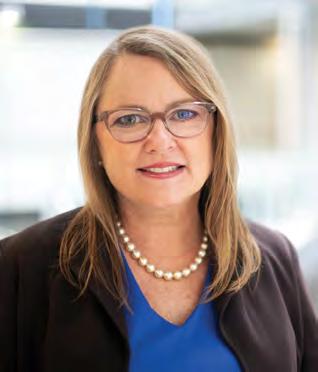
President Elect Michael D. Upton, M.D.’94 (2022-2024)
Secretary Heidi Schumacher, M.D.’10 (2022-2024)
Executive Secretary John Tampas, M.D.’54 (Ongoing)

Members-at-Large (Six-Year Terms)
JJ Bivona, Ph.D.’21 (2022-2028)
Annie Coates, M.D.’07 (2018-2024)
Brian Cuniff, Ph.D.’07 (2020-2026)
Seth Dorsky, M.D.’10 (2020-2026)
Janice M. Gallant, M.D.’89 (2021-2027)
Danie Leahy, M.D.’17 (2018-2024)
Gus Papadakis, M.D.’92 (2018-2024)
Anand Parthasaranthy, M.D.’02 (2022-2028)
Cordelia Ross, M.D.’16 (2022-2028)
Pramila R. Yadav, M.D.’99 (2021-2027)
Ex Officio Members
Richard L. Page, M.D., Dean Ginger Lubkowitz, UVM Foundation
Mary Cushman, M.D.’89, M.Sc.
President, University of Vermont
Larner College of Medicine Alumni Association
I
am so pleased to begin my term as president of the University of Vermont Larner College of Medicine Alumni association. I follow in some big footsteps: my friend Omar Khan, M.D.’03 set a high bar with his leadership throughout a challenging time—the greatest health crisis in a century. Throughout the pandemic, backed by our great alumni association staff, Omar worked hard to keep us connected to our medical alma mater, and I know I speak for the entire community of Larner grads when I thank him for his leadership.
Here on campus in Burlington, things are settling down to a “new normal”—with in-person and hybrid meetings and classes. COVID never stopped progress at our College of Medicine. There were many research achievements during the pandemic, including practice guidelines changing research about COVID. Extramural research funding is at an all-time high. I was thrilled that more medical students than ever completed alumnifunded research projects this summer; they are the hope for our future. And we are all extremely happy to see the final steps in the completion of the new Firestone Medical Research Building. Larner scientists and their research teams and students start to move into its labs this fall with great anticipation.
Research is challenging under the best of circumstances. We go to work each day trying to improve people’s health and lives. At UVM we have remarkable researchers from many disciplines who collaborate and innovate together across this University. To accomplish this now and in the future requires modern spaces to support our research and allow us to convene across disciplines. Those facilities are vital to continuing to attract outstanding new faculty and students from different backgrounds who are focused on discovering new treatments and cures. The positive impact of the new Firestone Building cannot be understated. As a UVM scientist myself, we are all so thankful to the many alumni who have supported its fundraising, particularly our lead donor, Dr. Steve Firestone from the Class of 1969. I’ve personally supported this project, and I hope that all our graduates will consider doing the same. No donation is too small.
The new Firestone Building is not the only milestone this year. Next May we will celebrate the 200th anniversary commencement at our College! You’ll see many important moments in our history detailed in this issue of Vermont Medicine, with more to come through our bicentennial year. In 1823, just four students were granted M.D.s. More than 120 new physicians will graduate in 2023. What changes we’ve seen in the art and science of medicine over two centuries— even over the course of our own careers—and what progress lies ahead!
One of my goals for my tenure is to enhance alumni participation and support of our students—whether it be writing a white coat note, mentoring a student, conducting an admissions interview, or supporting the College with a gift to the annual fund or other area of interest—there are so many ways to be involved. I hope you will join me in supporting medical students and researchers in whatever way suits you this year. Thank you for all you do for your patients, your profession, and your College of Medicine.
VERMONT MEDICINE FALL 202250 HALL A mary.cushman@med.uvm.edu @MaryCushmanMD
PRESIDENT’S CORNER NEWS & NOTES FOR ALUMNI
CLASS NOTES
1960s
REUNION 2022: 1962 + 1967
’69 James Cahill: Our world has dramatically changed from 1969. Currently almost retired.
’63
Arnie Kerzner is a Child Psychiatrist, continues to love his work, and is currently a Consulting Psychiatrist at the Lighthouse School interviewing children, supervising residents, and meeting with parents.
At times, he consults with his daughter, Leslie Kerzner, (UVM’85)
Oncologist at MGH. For RnR and lobster, the family retreats to their cottage in Cape Elizabeth, Maine.
Arnie received The Distinguished Senior Fellow Award from the American Academy of Child and Adolescent Psychiatry. He would love to hear from his UVM buddies, as Med School was one fantastic experience.
’65 Jan Mashman: Retired and living in Charleston.
Children are in Atlanta and St. Louis. Grandchildren are in Atlanta, NYC, Memphis. Life is good. Susan and I are both well.
Working 4 hours weekly with patients addicted to opiates. I’m happy to turn the practice of medicine over to the next generation. I hope they improve on our profession.
1970s
REUNION 2022: 1972 + 1977
’72 Mark Dubay: Ever since I graduated medical school, I’ve kept my Vermont medical license, even though I never practiced in Vermont. After I finished my main career in 2008 I began doing locum tenens assignments in Vermont. I have worked in Brattleboro, Newport and mainly in Morrisville. I never thought keeping that license would allow me so many cherished memories.
Helena, CA to help them, as medical director, to develop an accredited breast center in 2021. Previously, I had served as Medical Director of two accredited breast centers, as well as a surveyor for the National Accreditation Program for Breast Centers. I’m In good health, so far, with plans to travel to the East Coast in August, Israel in October/ November, Kauai in February the Iberian peninsula in May and Egypt/ Jordan next Fall. I have 3 wonderful, accomplished children as well as 3 grandchildren, all of whom I hope to see in person soon. Wish I could see my classmates at our reunion this fall, but I’ll be out of the country. Good health & happiness to all.
’72 James Mogan: Outside of the typical getting old infirmities, we have been truly blessed with good health. We are looking forward to a wonderful Med School reunion with old friends! We all have much to be thankful for, Jim and Pat
’68
Jeffrie Felter: Fully retired from active practice after 45 years and still missing patient contact.
I will now be concentrating on travel, non-technical reading, visiting family and a bit of woodworking.
’72 John Waterman: Really enjoyed being editor of the class year book. Working with all the folks that contributed to that year book was the highlight of my senior year. Thanks to all you helped produce it.
’72 Charles Elboim: I just retired for a second time after I was asked by Adventist Health in St.
SUBMIT CLASS NOTES ONLINE
’74 David Edsall: Although I have thoroughly enjoyed the first five years of retirement as a Snowbirding Maine laker, I am changing to a NH laker – mesa Snowbirder. I had a serendipitous experience of three unconnected books mention and re-instill in me the concept of tikkun olam. One
The UVM Alumni Association offers an easy-to-use online form to submit class notes. You can also browse class notes by year, school or college, or note type. Submit your class note and read more from classmates:
medclassnotes
UVM LARNER COLLEGE OF MEDICINE 51
go.uvm.edu/
Share your news or updated contact information at go.uvm.edu/infoupdate, or contact your class agent, or the Larner Development & Alumni Relations office at medalumni.relations@med.uvm.edu or 802-656-4014
UVM Connect allows graduates across the University to join groups based on interests or affinity. There’s a UVM Larner College of Medicine specific networking area you may find very valuable. Stay connected at: uvmconnect.org HALL A STAY CONNECTED!
The Quiet Leader
THOUGH IN THE 1940 s he turned down the first of several offers to become the UVM College of Medicine’s dean, in all other areas of his career A. Bradley Soule, M.D.’28 demonstrated just how much one person can influence the course of an institution. Born in St. Albans, Vt., in 1903, he came to UVM as an undergraduate in the fall of 1921. After his graduation from the medical school and a residency in Massachusetts, he returned to Vermont, and served the University and its medical school for the next 54 years. They were turbulent times at first: the American Medical Association
(AMA) had threatened revocation of the College’s accreditation. Dr. Soule was instrumental in the reorganization of the College to the AMA’s satisfaction, and he founded the Department of Radiology in 1937 and served as its first chair. Throughout the following decades, he was instrumental in the development of the College’s faculty, infrastructure, curriculum, and alumni association. In retirement he guided the association as Director of Alumni Affairs until shortly before his death in 1983. Today, the highest alumni award the association bestows is named in his honor.
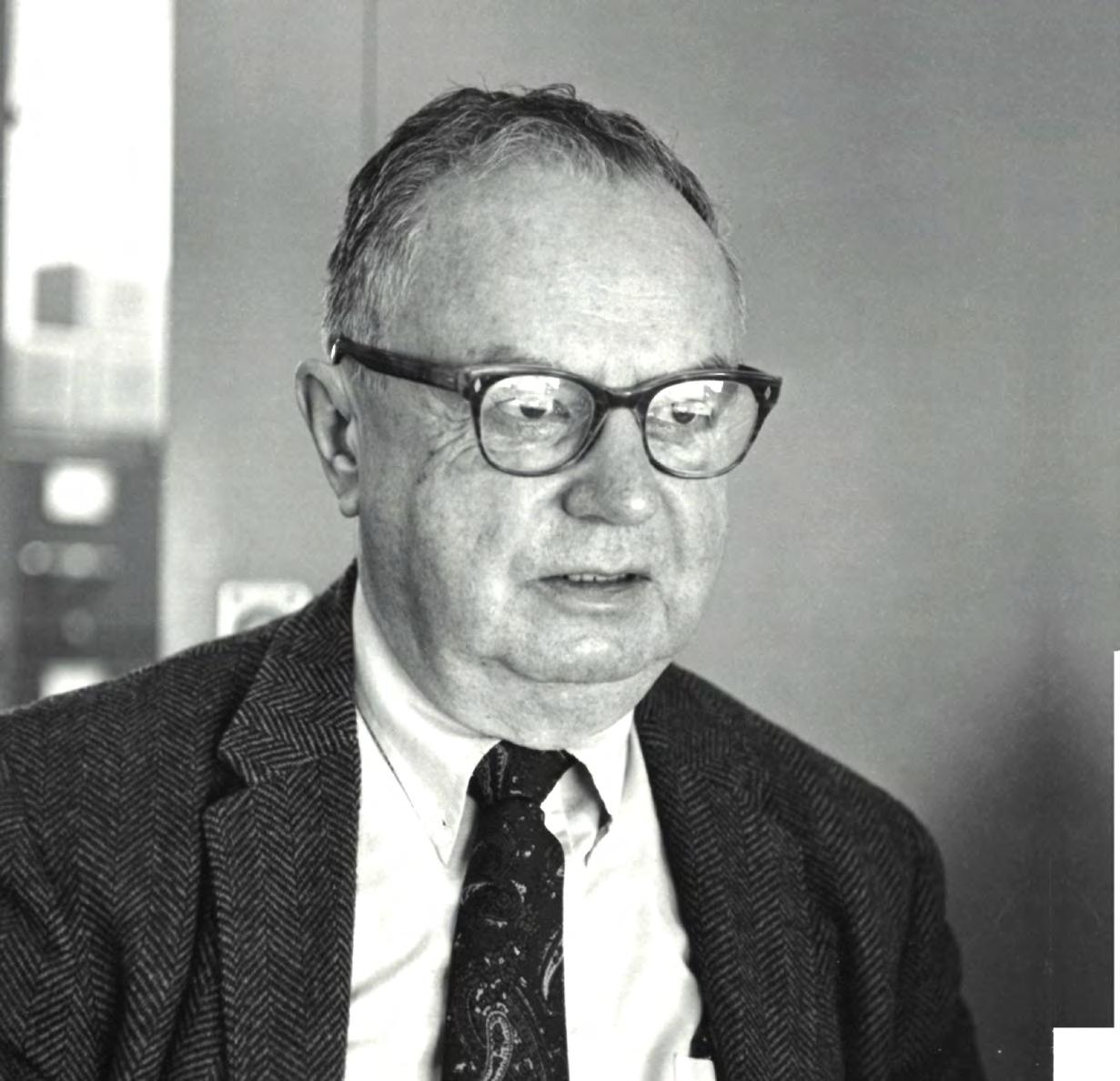
A. BRADLEY SOULE, M.D.’28 VERMONT MEDICINE FALL 202252 ALUMNI VIGNETTE
book being ‘Hacking the American Mind’ by a pediatric endocrinologist. So I have taken up being a USMS adult learn to swim instruction. It is not like trauma anesthesia but still saving lives and gives a better sense of purpose.
’74 Joe Hebert: Pamela and I are now retired and spend our winters in Tucson. Our grandson Devin will be enrolling in the LCOM class of 2026 following in the footsteps of our son Chris who graduated in 2002. Three generations!
’75 Steve Haines: Enjoying retired life in Blaine, Washington (North American home of the Giant Asian Murder Hornet, Vespa mandarinia. Planning to attend the October 14-16 reunion activities. Aside from our 50th being somewhat truncated by Covid, there will be a special Alumni Early Achievement Award posthumously to Molly Hubbard ’12. Molly came to the University of Minnesota Neurosurgery Residency program after graduation from Vermont and matured from a very special medical student into a very special neurosurgeon. She joined a small but remarkable group of neurosurgeons with strong UVM ties, and for a time the oldest living graduate of the Minnesota program, the newest member of the program and its chairman were all Larner UVM graduates. She had secured a faculty position at Oregon Health & Science University when she died in an avalanche while skiing in Idaho. Her class, her fellow residents and her future boss all joined in the effort to have her recognized with the Early Achievement Award. It will be a very special time.
’75 John Rowe: I lost my wife to cancer two years ago. When she got sick, I essentially stopped work to take care of her over her final six months. Since then, I have moved to Durham NC where my three children all live, along with four grandkids. It has been an excellent move. I continue to do about an hour’s worth of remote work with the MAHEC Family Medicine Residency In Asheville, N.C. for which I have worked for 28 years. But otherwise I am retired. I plan to attend the 45th reunion in October. Hope to see some old friends there.
’78 John Healey I am eternally grateful for how UVM nurtured my calling to the profession, helping me to enjoy a career exceeding my
wildest expectations. I am stepping down as Orthopaedic Surgery Chief after 32 years, the longest tenure in any specialty in Sloan Kettering. I will split my time between Univ. Texas Austin and my current practice in NYC, completing my research grants, supporting the service transition, and enjoying my four grand children in Texas and Illinois. My wife Paula continues to define national policy in many areas including as a Scholar at the Johns Hopkins Center for Health Security (generating all the Covid data) and Chair of EPA Research Committee advising on water safety issues. I revel in her success. I took great satisfaction in publishing my 400th peer review article and in the leadership my graduated trainees have achieved internationally, including only the second woman to Chair an Orthopaedic Department. nationally, and many who have become Presidents of our specialty organiza tions and university service chiefs internationally... my professional legacy. Finally I am invested in various philanthropic organizations, including Board memberships in the UVM Foundation, the University of Notre Dame Graduate School Advisory Council, Musculoskeletal Transplant Foundation, among others, as ways to give back for the many opportunities with which I have been blessed. It is with great affection that I recall my med school classmates, teachers, and days at UVM. Thank you. I welcome the chance to speak with and share time with any and all. Please contact me. healeyj@mskcc.org 347-380-2463.
Royal Orthopaedic Hospital, plus continuing as a Consultant in Neurodisabilities for the NHS. Can’t seem to retire quite yet. There’s always folk music I suppose. We’re also happily, new grandparents of Lilly and relearning pediatrics all over again! We always think about and miss UVM and hope to see everyone at our next reunion. We are so sorry to have missed the reunion in June but wish everyone our very best. It’s been a bit tricky moving between Old England and New England but as Nora and I slow down a bit we’ll be back to the States more often. Meanwhile I hope to leave the clinical and academic world caring for children with complex disabilities a little better than I found it, but if the opportunity to continue part time somewhere in New England ever came up we’d be there!
’81 Roslynn Glicksman: I got married this year! Also, I finally have a retirement date – September 23, 2022. I expect to do some medical work in the future but with limited hours and less stress. Sorry I
missed this year’s reunion (my mother died five days earlier) but I’ll definitely catch the next one. Roslynn
’81 Andrew Weber: Laury and I had such a good time at our 40th reunion. Dinner with Betsy and Larry, lunch Margie and Peter, Bob Cochran caddie and dinners at Bruce and Ann!
’82 Fred Schlussel: Big year 2022: 40th class reunion! My daughter’s graduation from Larner College of Medicine, 40 years to the date from my graduation!
’82 Mike Saxe stepped down as Chair of Emergency Medicine at Middlesex Hospital in Middletown, CT in 2017, then tapered down from half time to complete retirement over three years. His wife, Andrea Schaffner, M.D., passed away from cancer in March, 2022. He has three sons and three stepchildren in their 30’s, plus two step-grandchildren. He has become a passionate tennis player and world traveler. Looking forward to his 40th class reunion in October!
’78
Edward McCarthy: My 70th year still finds me involved part-time with the practice of Ophthalmology, my wife and I always remembering our time at UVM with fondness and gratitude as it seems like only yesterday that we were there. Thanks UVM.
1980s
REUNION 2022: 1982 + 1987
’80 David Zeiler: Happily retired since 2017. Living in the NC triangle area.
’81 Lawrence Kaplan: Nora and I still maintain our home in Essex, Connecticut and reside in the UK where Nora is on the faculty of University College London and I am at Imperial Medical School, London, with an additional role in teaching and curriculum development at
UVM LARNER COLLEGE OF MEDICINE 53
CONFERENCES ARE PLANNED FOR IN-PERSON, SUBJECT TO CHANGE. For Information Contact: UNIVERSITY OF VERMONT CONTINUING MEDICAL AND INTERPROFESSIONAL EDUCATION 401 Water Tower Circle, Suite 102 • Colchester, VT 05446 802-656-2292 • UVMCMIE@med.uvm.edu • med.uvm.edu/cmie UVM CONTINUING MEDICAL AND INTERPROFESSIONAL EDUCATION EMERGENCY MEDICINE 2023 CONFERENCE January 22-25, 2023 • The Lodge at Spruce Peak • Stowe, VT HOSPITAL MEDICINE 2023 CONFERENCE January 29-31, 2023 • The Lodge at Spruce Peak • Stowe, VT 34TH ANNUAL EASTERN WINTER DERMATOLOGY CONFERENCE February 2-5, 2023 • Stoweflake Mountain Resort • Stowe, VT UVM MEDICAL CENTER CARDIOVASCULAR/VASCULAR FORUM April 3, 2023 • Delta Hotel by Marriot • South Burlington, VT STEM CELLS, CELL THERAPIES, AND BIOENGINEERING IN LUNG BIOLOGY AND DISEASES July 17-20, 2023 • UVM Davis Center • Burlington, VT HALL A
Scholarly Summer
For students pursuing a degree in medicine, there’s no off-season. Thanks to alumni support through the Larner College of Medicine Fund, the seven-week break after the first year of medical studies becomes a time for many students to tackle projects in clinical, basic science or health policy that address unmet health needs, sharpen clinical skills, and immerse themselves in specialty clerkships with physician preceptors. The process: pose a hypothesis and perform a basic science or clinical experiment with data collection and analysis to address that question and provide new insight and knowledge. Many of these studies become published in scholarly journals.
More research projects are detailed at med.uvm.edu/vtmedicine/web-extras
To support student research with a gift to the Larner College of Medicine Fund, visit: go.uvm.edu/givemed or contact the Development and Alumni Relations Office at 802-656-4014.
Mimi Falcone ’25
IMMIGRANT FAMILY AUTISM SUPPORT
At a space called the “family room” in Burlington’s Old North End, Mimi Falcone (above, left) sits with a group of New American parents whose children are on the autism spectrum. The group gathers twice monthly to socialize and gain insights on themes such as wandering prevention, with support from social workers and volunteers.
Falcone surveyed the parents about their stress related to taking care of their child with autism. She tracked the impact that a peer support group has on relieving stress among these immigrant parents.
“Parents with neurodiverse children often are cast aside and forgotten. Many of these parents have limited English proficiency and minimal family nearby, so they feel isolation to an even
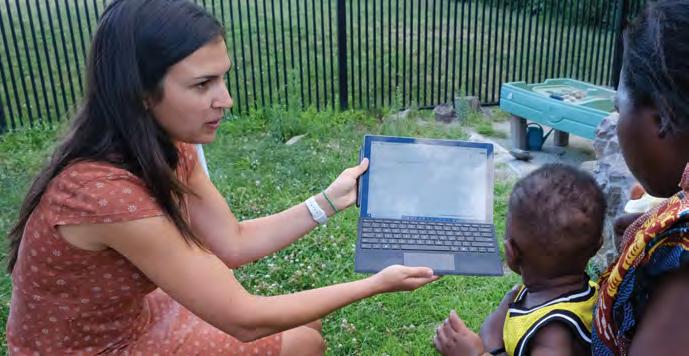
Karena Nguyen ’25
SCREENING DISPARITIES AMONG VERMONT’S BIPOC POPULATION
As a future physician, Karena Nguyen (at left) is eager to understand environmental and social factors that affect health, including access to food and clean water supply, public transportation, and disability compliance. This summer, Nguyen assessed health disparities in the usage of breast cancer screenings in Vermont.
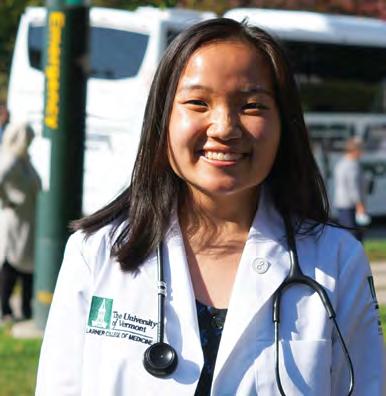
“My hope is that this project can help pave the way to improve health equity among the underserved populations in Vermont, similar to how the COVID-19 vaccination rate gap closed between BIPOC and white Vermonters after data elucidated the disparity,” said Nguyen.
larger degree,” said Falcone. “The hope is that this style of peer support group has a positive effect on the participants and their families.”
Falcone hoped to show that peer sup port groups build healthy communities and improve health care outcomes for immigrants. Early evidence shows she’s on track: “So far, having a consistent time and physical meeting place for par ents to decompress and share what’s on their minds is proving to be instrumental in reducing the stress felt by the parents involved in the group,” she said.
Falcone hopes to be an ally, advocate and educator within immigrant and low resource communities. “I see myself working to improve health and wellbeing at a population level just as much as with Individuals in an exam room,” she said.
The work she refers to—numerous outreach efforts to connect the Black, Indigenous, People of Color (BIPOC) communities to the COVID-19 vaccine— were essential in mitigating the racial and ethnic disparities in Vermont’s vaccination rates.
A California native, Nguyen volunteered for Special Olympics, food banks, and a cancer support center in San Francisco. She currently works with the Vermont Health Equity Initiative to promote mental health and well-being among the BIPOC population. During the early days of the COVID-19 pandemic, Nguyen worked as a scribe for Southeast Health Center, observing firsthand the importance of documenting social determinants of health, particularly for marginalized communities of color.
VERMONT MEDICINE FALL 202254 HALL A
’82 Glenn Englander: Hope all are well. My GastroGroup is now employed by Tampa general hospital so I plan to work another 4-9 years (It was 5-10 but then I had a birthday.) Trying to travel more, visit daughter in Brooklyn. If you are in palm beach county, call! P.S. I can’t be there alumni weekend because my niece decided it was a good Saturday to get married.
’82 Diane Rippa: I retired in December 2021, after working for 37 years as a family physician in Essex, Vermont. It was hard to say goodbye to so many wonderful patients and co-workers but I was definitely ready to retire. I’ve been enjoying time with my newly retired husband David traveling, biking, kayaking, and visiting our children and grandchildren.
’83 Stephen Payne: After practicing general surgery for 34 years at Northwestern Medical Center in St. Albans, Vermont, I will be retiring in June of this year. It has been a privilege and pleasure to serve the patients of northern Vermont. I’ve enjoyed a close working relationship with many colleagues at UVM over the years and look forward to continuing to serve on the part-time surgical faculty. My retirement plans center around continuing my career as an author, with two new novels arriving over the next couple of years. Info at www.StephenRussellPayne. com or on facebook at StephenRus sellPayne, Vermont Author.
’83 Michael Narkewicz: I am coming to the end of my first year of phased retirement. I remain at the University of Colorado SOM and Children’s Hospital Colorado. I have a primary role as physician executive for Children’s and still do ambulatory Pediatric Transplant Hepatology and research in Cystic Fibrosis Liver Disease. After nearly 40 years, it’s nice to have time set aside that is separate from work. My wife Dana Shepard and I enjoy hiking and fly fishing and snow shoeing. If you are out Denver way, let us know.
’83 Rosanna Musselman: I’ve been retired since 2018 so I missed the COVID crazy. My husband Steve, our two fur babies and I are enjoying living on Cape Cod in our new home we built for “aging in place”.
’85 Daniel Hovenstine: Enjoying my retirement from practice in Southern California. I can’t believe it’s been 40 years since sitting in Hall A! My classmate Eduardo Anorga is still my primary care physician out here on the West Coast! Best wishes to everyone.
’87 Davidson Hamer: I have had the great fortune of spending the last six months doing a sabbatical at Unisanté in Lausanne and the Swiss Tropical Public Health Institute. While greatly improving my spoken and written French, I have developed some new collaborations for stunting and antimicrobial resistance research in Africa and imported emerging infectious diseases (from chikungunya to dengue to monkeypox). During the six months as I return to my full time position at Boston University, I will have the added challenge of serving as the Acting Director of the BU Center for Emerging Infectious Disease Research and Policy. Exciting and busy months ahead!
’89 Dean Mastras: I am very proud that my Daughter, Kassandra Marie Mastras, will be entering The UVM Larner College of Medicine this Summer for the class of 2026! Kassie makes this the third generation of UVM medical school graduates following the path of her grandfather, George Mastras, Class of 1959, and her dad, class of 1989. Kassie will actually be the fourth generation of physicians in the family with her great grandfather, Constantine Zariphes, a Boston University Medical School Graduate. I now look forward to spending more time now in beautiful Vermont and getting back in touch with some of my classmates while visiting Kassie.
1990s
REUNION 2022: 1992 + 1997
’91 Kathryn McQueen: I am starting the Drexel University Executive Leadership for Academic Medicine Fellowship – an incredible opportunity for Women Leaders. I look forward to learning and growing, and advancing opportunities for women in leadership in the future.
’93 Stanford Plavin: As a member of the class of 1993, I would like to wish the best to my colleagues. It is difficult to imagine that almost 30 years has gone by since we finished up at UVM. Just a brief update;
Coming up on 30 years of marriage with my wife Tally. We married one week after graduation. We have two wonderful children; our son, Shane is finishing up his JD at Emory Law this upcoming year. Our daughter is a management consultant for Collective Insights and is known around the country as the Charcuterie Chick.
’93
Steven Shapiro: Greetings all!
As of July 15th, I am retired! The adventure continues...
’94 Karin Berg: Dear all, hope everyone is doing great! I’m really looking forward to starting as a faculty member at the UVM Larner College of Medicine in the fall.
’95 Ron Balassanian: I’m a professor of pathology at UCSF focusing on fine needle aspiration biopsy, global health and patient communication. I’ve been working with medical students, residents fellows and pre-med interns. I’ve really enjoyed being in academics and it feels like I never left school.
’96 Mark Vining: After 25 years, Mark Vining and Scott Wexelblatt (both ’96) reunited as participants in the Controversies in Well Newborn Care Debate at the Academic Pediatric Association annual meeting in Denver, CO in May 2022.
’97 Brett Ian Gingold is looking forward to reunion. He has been practice sports orthopaedics in Bend, Oregon. He is the Masters Champion Ski Racer at Mt. Bachelor, where he also teaches jumping and tricks at the ski school. He lives with his horses and dogs on a ranch and invites all to his annual BIGstock festival.
2010s
REUNION 2022: 2017
’12 Melissa Marotta Houser is pleased to announce the launch of All Brains Belong VT, a 501(c)(3) nonprofit neuroinclusive healthcare and community organiza tion in Montpelier, VT. All Brains Belong provides primary care, social connection opportunities for kids and adults, and education trainings about neurodiversity, accessibility, and neuro-inclusion. Check out allbrainsbelong.org to connect and get involved.
’16 Christine Tran wrote to the incoming Cl;ass of 2026: It is going to be such a wild and crazy ride, but also such an amazing one. Don’t forget to stop and take it all in once in a while, UVM is truly a special place. Congrats, work hard and have even more fun!
’17 Gwen Warren: Hi guys! I did my active duty family medicine residency at Travis Air Force Base in California, then went to Kunsan Air Base in South Korea for a year. Now I’m stationed at the Pentagon for the next three years, (there’s a primary care clinic and acute care in the building) although as I write this I’m deployed for FEMA COVID support. Hit me up if you’re in DC : )
’17 Amy Schumer: I’m in my second year of maternal fetal medicine fellowship back at UVMMC. Chris completed a fellowship in neuromuscular medicine at Mass General Brigham and is starting a job in Plattsburgh, NY this fall. We just had a baby boy, Henry, born in June and are now all living in Burlington.
’17 Johanna Kelley: Joey and Dave just celebrated the first birthday of their daughter, Mae Anderson Curley, who was born at UVM. They are settling in to Cleveland, Ohio as Joey starts her second year of fellowship in gynecologic oncology residency training at Eastern Virginia Medical School in Norfolk.
’12
Mariah Stump received two subspecialty board certifica tions in Integrative Medicine (after completing a two year fellowship) and in Lifestyle Medicine. She is the Course Director for the Introduction to Lifestyle Medicine clinical elective at Alpert Medical School, Brown University where she is an Assistant Professor of Medicine, Clinician Educator. This year, she received the Department of Medicine Teaching Award.
UVM LARNER COLLEGE OF MEDICINE 55
HALL A
A Healing Heart
JACQUELINE
J ACQUELINE NOONAN , M.D.’54
not only became the first member of her family to get a bachelor’s degree, but the first to earn a medical degree as well—and the “firsts” kept on coming.
Nine years after graduating from the then UVM College of Medicine and practicing as a pediatric cardiologist, Dr. Noonan cemented her place in medical history by becoming the first person to identify a rare hereditary heart disorder present in only one in 1,500 infants. The disorder, which is
characterized by heart malformations and unique physical characteristics, was later named “Noonan Syndrome” after her pioneering discoveries and papers about the disorder. Dr. Noonan’s additional accomplishments include becoming a founding faculty member at the University of Kentucky, where she served as chief of pediatric cardiology for 37 years, and her role as the chair of pediatrics for 18 of those years. Dr. Noonan died in 2020 at the age of 91.
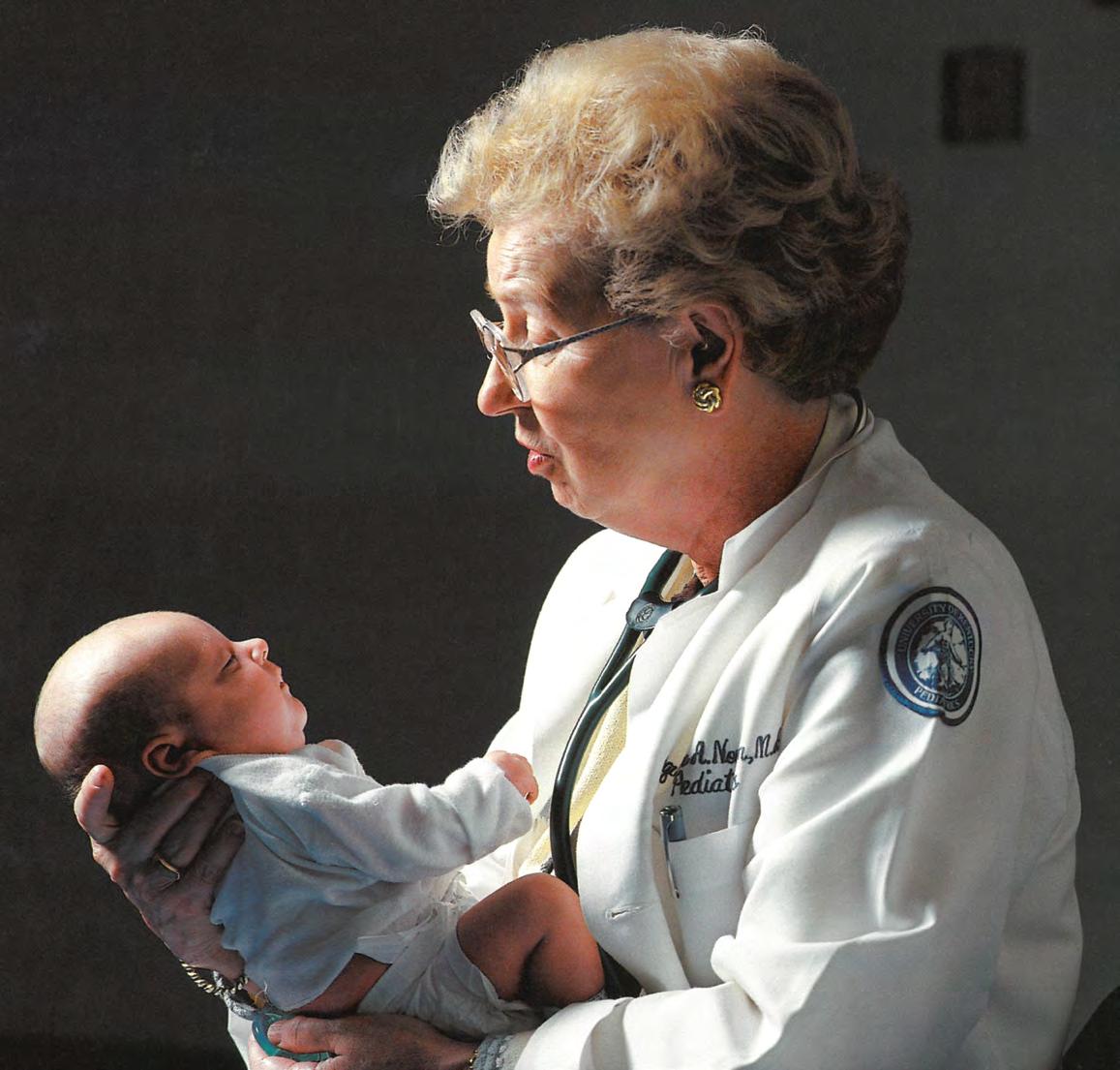
VERMONT MEDICINE FALL 202256
NOONAN, M.D.’54 ALUMNI VIGNETTE
NEW GREEN AND GOLD PROFESSORSHIPS
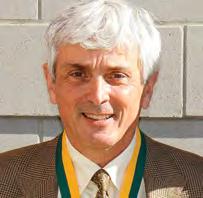
Four endowed Green and Gold professorships conferred through July of this year upon members of the UVM Larner College of Medicine community. Endowed positions, which are among the highest academic honors that UVM can bestow on a faculty member, recognize and celebrate academic achievement, further encourage scholarship, service, and clinical excellence, and help recruit and retain the most creative researchers, most effective teachers, best clinicians, and finest leaders.
Diego Adrianzen Herrera, M.D.
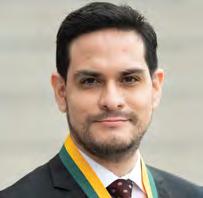
Diego Adrianzen Herrera, M.D., was invested in January as the inaugural holder of the Early Career Green and Gold Professor of Medicine. Dr. Herrera is an assistant professor of medicine in the Division of Hematology/ Oncology, member of the UVM Cancer Center, and pipeline investigator of the Vermont Center for Cardiovascular and Brain Health. This Department of Medicine-funded professorship is designed to provide funds to strengthen the research program of the most promising assistant professors in their first five years of their faculty appointment and recognizes the excellence and potential of the recipient’s research program.
Melissa Davidson, M.D.
On February 7, 2022, Melissa Davidson, M.D., a faculty physician leader at the Larner College of Medicine, was invested as the inaugural holder of the Howard Schapiro, M.D.’80 and Janet Carroll, M.S.N., M.P.H., Green and Gold Professorship in Anesthesiology. This endowed professorship was made possible through the generosity of both its namesakes, married couple Howard Schapiro, M.D., and Janet Carroll, M.S.N., M.P.H., and the faculty of the Department of Anesthesiology in honor of their former chair, Dr. Schapiro.
William Brundage, M.D.
In June, Associate Professor of Surgery William Brundage, M.D., was invested as the inaugural Green and Gold Professor in the Division of Otolaryngology, Head and Neck Surgery. Brundage also serves as division chief of otolaryngology at the University of Vermont Medical Center. In 2013, the Department of Surgery’s faculty collectively established 14 Green and Gold Professorships—one in each of the department’s divisions—to demonstrate their high regard for resident and medical student training, research and innovation, as well as patient care.
Danielle Ehret, M.D., M.P.H.
Associate Professor of Pediatrics and neonatologist Danielle Ehret, M.D., M.P.H., was invested as the inaugural Asfaw Yemiru Green and Gold Professor in Global Health on July 28, 2022. This endowed professorship was established by the Vermont Oxford Network (VON) in honor of Asfaw Yemiru, the Ethiopian educator and humanitarian. VON is a nonprofit, collaborative association of over 1,200 neonatal intensive care units in 38 countries whose data-driven quality improvement work has led progress in the care for newborns and their families for more than 35 years.
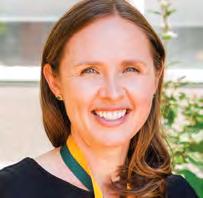
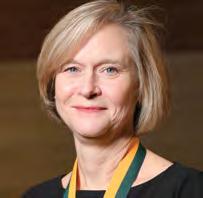
INAUGURAL OGUEJIOFOR DIVERSITY SCHOLARSHIP RECIPIENT NAMED
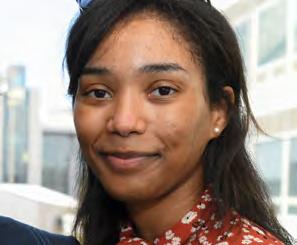
For the recently graduated medical Class of 2022, their “class gift” took on even greater meaning, as it was directed to the Collins Oguejiofor Diversity Scholarship established in honor of their former classmate who died unexpectedly at the end of their second year.
“One of the challenges we’ve faced together as a class has been loss and grief,” said class agent Luke Higgins, M.D.’22. “We grieved Collins’ passing as a community. I think it helped us process and respond and eventually take actions in honor of his memory.”
The Oguejiofor Fund, established in the fall of 2020 with gifts from family, students, faculty, staff, friends and the UVM Larner Alumni Association, quickly reached the $50,000 endowment threshold, meaning the fund will exist at UVM in perpetuity. The fund supports medical education scholarships for students from backgrounds similar to Collins and will forever reflect the heart of its namesake. In April, Class of 2024 medical student Kiana Heredia was named the inaugural recipient of the Oguejiofor Scholarship.
“One of my goals in life is to highlight the power of representation and diversity within our society,” said Heredia.
The University of Vermont
College of Medicine
Development
UVM LARNER COLLEGE OF MEDICINE 57
Larner
Medical
& Alumni Relations Office (802) 656-4014 medical.giving@uvm.edu med.uvm.edu/alumni
DEVELOPMENT NEWSMEDICAL DEVELOPMENT AND ALUMNI RELATIONS
AWARDS
The UVM Larner Alumni Association Awards are presented every year at the Celebration of Achievements Awards Ceremony during Reunion weekend. More details about the awardees can be found at med.uvm.edu/alumni.
A. BRADLEY SOULE AWARD
Presented to an alumnus/a whose loyalty and dedication to the Larner College of Medicine most emulate those qualities as found in its first recipient, A. Bradley Soule, M.D.’28.
H. David Reines, M.D.’72, FACS, FCCM
DISTINGUISHED GRADUATE ALUMNI AWARD
Presented to an alumnus/a from the UVM Larner College of Medicine’s Ph.D. or M.S. programs who has demonstrated outstanding achievement in basic, clinical or applied research; education; industry; public service/humanitarianism; and/or outstanding commitment to the Larner College of Medicine community.
DR. REINES graduated from Cornell University in 1968 before coming to the College of Medicine. In medical school he co-founded “The Place,” to provide emergent care for drug users and to help identify dangerous contaminants in psychedelic drugs that were making their way into the state. He remained in Vermont for his surgical residency and a cancer fellowship, but found he was particularly interested in critical care and trauma. During his years in Vermont, he married nurse Martha Virginia Orton. After completing a critical care/trauma fellowship at Jackson Memorial Hospital in Miami, he joined the faculty at the Medical College of South Carolina in Charleston, where he helped organize the first trauma unit in the state. He became the chair of the state committee for trauma and was surgical director of the South Carolina EMS system. Dr. Reines went on to direct the trauma and critical care units at the Medical College of Virginia, (now Virginia Commonwealth University). In 1991, he was appointed chair of surgery at Newton Wellesley, a Partners hospital, in Eastern Massachusetts. In 2001, he was appointed vice chair of surgery at Inova Fairfax Hospital in Virginia, where he established the first new surgical residency in the United States in many years. He became clerkship director for VCU students and served as an attending on the Trauma/Critical Care/Acute Care Service.
Professor of Surgery, George Washington University Medical School; Clinical Professor of Surgery and Master Educator, University of Virginia School of Medicine
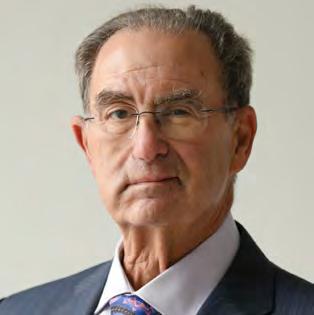
Dr. Reines has been a Professor of Surgery at Tufts University Medical School, at MCV/VCU, at Howard University School of Medicine, and is currently a professor at George Washington University Medical School and the University of Virginia School of Medicine, where he was appointed Clinical Professor of Surgery and a Master Educator. He continues to be active in teaching and research and has been very active in policy for the American College of Surgeons. He was appointed to the Council on Graduate Medical Education (COGME) by the Secretary of Health and Human Services, and subsequently became the chair of the committee, advising both the Secretary and the Congress on issues affecting Graduate Medical Education. Last year he was admitted as an Associate Member of the ACS Master Surgeon Educators.
Dr. Reines is the author of 120 peer reviewed publications, as well as multiple chapters on critical care, trauma, and surgical education. He was an editor of the first national book on “Medical Control for EMS.”
For the past six years, Dr. Reines has served as secretary of the board of the Christian Medical College Foundation in Vellore, India, and has been instrumental in helping design and establish the first Trauma center in South India, one of only three in the country. Recently has been appointed to the Inova Foundation Board.
In the last decade, along with his wife, Nina Totenberg, has endowed a scholarship that benefits several New England students each year. He has also served several roles with the UVM Foundation and is chair of the Firestone Medical Research Building Campaign Committee.
Elizabeth J. Kovacs, Ph.D.’84
Professor of Surgery, and the Director of Burn Research and the Alcohol Research Programs, University of Colorado Denver Anschutz Medical Campus
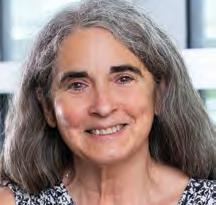
VERMONT MEDICINE FALL 202258
Do you know a class member deserving of recognition? Send your nominations for the 2023 awards to: med.uvm.edu/alumni 2023 NOMINATIONS 2202 U V M LARNERCOLLEGE OF MEDICINEALUMNI A S S O C A I TNOI
DISTINGUISHED ACADEMIC ACHIEVEMENT AWARD
Presented to alumni in recognition of outstanding scientific or academic achievement.
James R. Howe, M.D.’87
Professor of Surgery, Surgical Oncology and Endocrine Surgery; Co-Director, Neuroendocrine Cancer Clinic; Director, Division of Surgical Oncology and Endocrine Surgery,University of Iowa Health Care Carver College of Medicine
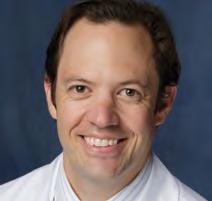
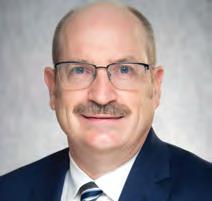
EARLY ACHIEVEMENT AWARD
Jacqueline S. Jeruss, M.D. ’97, Ph.D., FACS
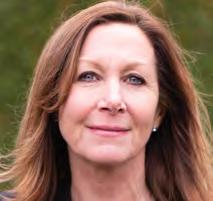
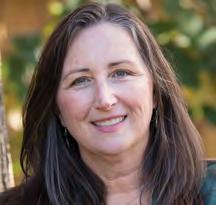
Professor of Surgery, Pathology and Biomedical Engineering; Associate Dean for Regulatory Affairs; Director, Breast Care Center and Breast Surgical Oncology Fellowship; Michigan Medicine, University of Michigan Department of Surgery, Division of Surgical Oncology
Kennith Sartorelli, M.D.’87
Green and Gold Professor of Pediat ric Surgery, UVM Larner College of Medcine; Vice Chair for Education, Department of Surgery; Division Chief, Pediatric Surgery, UVM Children’s Hospital and UVM Department of Surgery; Surgeonin-Chief, UVM Children’s Hospital
Sharon Savage, M.D.’97
Chief of Clinical Genetics Branch; Clinical Director of Division of Cancer Epidemiology and Genetics; National Cancer Institute
SERVICE TO MEDICINE AND COMMUNITY AWARD
Presented to alumni who have graduated within the past 15 years in recognition of their outstanding community or College service and/or scientific or academic achievement.
Molly Hubbard, M.D.’12 (Posthumous award)
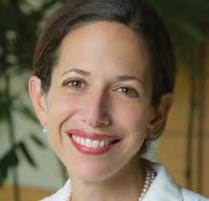
Fellow, Pediatric Neurosurgery, Oregon Health Science University Dr. Hubbard accepted an assistant professor position at OHSU, to begin the summer of 2020. An expert skier, she was one of three skiers killed in an avalanche in Kellogg, Idaho, in January 2020.
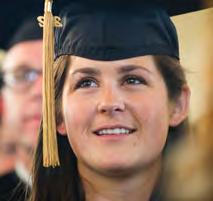
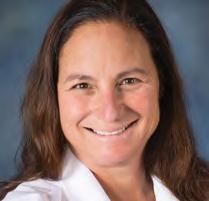
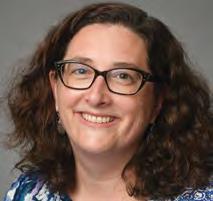
Adam Polifka, M.D.’07
Associate Professor, Department of Surgery, University of Florida
Presented to alumni who have maintained a high standard of medical service and who have achieved an outstanding record of community service or assumed other significant responsibilities not directly related to medical practice.
Mary Hamel, M.D.’92
Senior Technical Officer and Team Lead for Malaria Vaccines, World Health Organization; Medical Epidemiologist, U.S. Centers for Disease Control and Prevention; Senior Malaria Advisor, President’s Malaria Initiative
Susan Long, M.D.’92, FACS
General Surgeon, St. Joseph’s Hospital, West Virginia University Medicine
ROBERT LARNER, M.D.’42 STUDENT AWARD
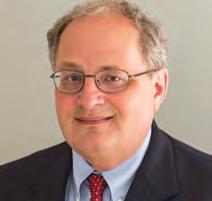
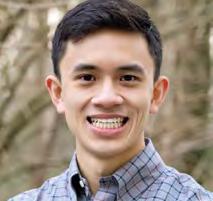
Presented to a current student(s) for their outstanding leadership and loyalty to the College and one who embodies Dr. Larner’s dedication to not only sup porting his medical alma mater, but to inspiring others to do so as well.
Vinh Le
UVM Larner College of Medicine, Class of 2023
Mariah McNamara, M.D.’02, MPH
Associate Professor of Surgery, UVM Larner College of Medicine; Attending Physician and Assistant Division Chief, Division of Emergency Medicine, UVM Medical Center; Associate Chief Medical Officer for Medical Staff Affairs, UVM Medical Center
UVM LARNER COLLEGE OF MEDICINE 59
Summer Reruns!
The Classes of 1971 and 1981 had to forego their 50th and 40th reunion during the “second Covid summer” of 2021. But not to be outdone by the coronavirus, both classes made up for the lapse one year later, with a special in-person reunion held on-campus and around Burlington the weekend of June 10-12, 2022.
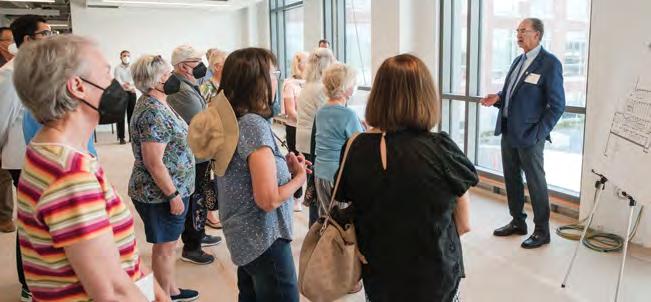
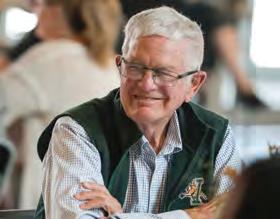
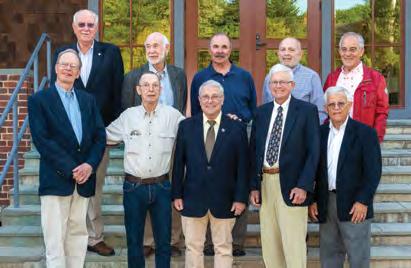
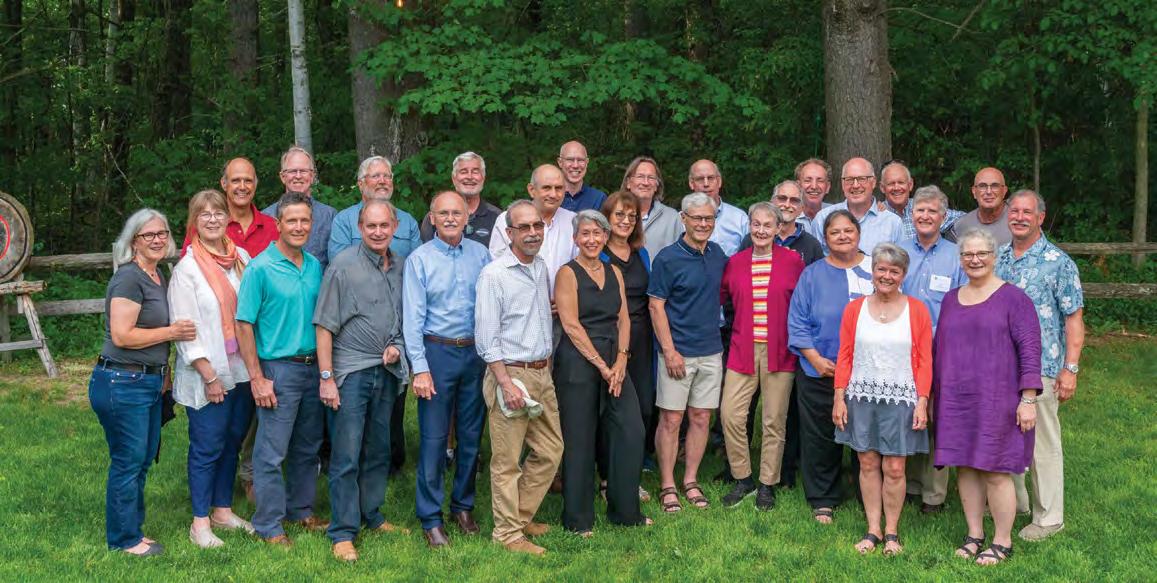
Class members caught up on new developments through a panel discussion with current students, and on campus tours, including an extensive look at the soon-to-be-completed Firestone Medical Research Building. They also heard a special grand rounds presentation on cancer care and integrative therapies, and found a good deal of time to socialize on the golf links and at special class dinners.
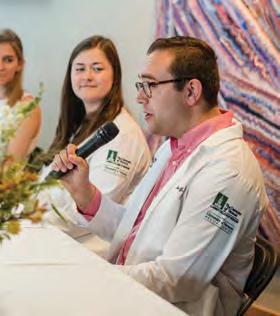
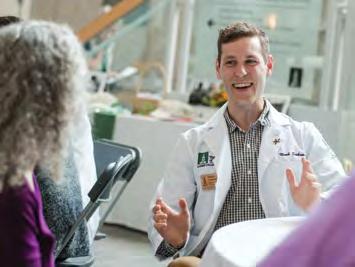
VERMONT MEDICINE FALL 202260 REUNION
OBITUARIES
’53 Bertrand P. Bisson, M.D.
Dr. Bisson died on March 30, 2022 at the VITAS Hospice Unit at St. Mary’s Hospital in Watertown, Conn. He was 94. After beginning his career at St. Francis Hospital in Hartford, he joined the U.S. Air Force, and in 1959, after an honorable discharge, joined St. Mary’s Hospital, where he stayed until he retired in 1991, and continued working many years after his retirement. In addition to his career, Dr. Bisson enjoyed cooking and tending to his garden.
’53 Wayne S. Limber, M.D.
Dr. Limber died of Covid-related complications on December 31, 2021. He was born in 1928 and spent his childhood on Long Island, where he developed his lifelong love of the ocean, and in Vermont, hiking and working the summers as a solo fire spotter. He attended Haverford College before earning his M.D. at the UVM. He served in the U.S. Air Force, and practiced in California before settling in Hawai’i, at Kaiser Hospital on Waikiki Beach. After 14 years, he moved on to the V.A. Hospital in Boise, Idaho, and finished his career at the V.A. Hospital in Spokane, Wash.
’55 Samuel Barrera, M.D.
Dr. Barrera died February 15, 2022 at his home in Canton, Mass. Born and raised in Middlebury, Vt., he earned both his B.S. and medical degrees at UVM. He began his internship at Carney Hospital before being stationed at Royal Air Force Station Wethersfield in Finchingfield, Essex, England. There he served in the U.S. Air Force as a General Medical Officer. He returned to the United States in 1958 to complete a obstetrics and gynecology residency at St. Margaret’s Hospital in Dorchester, Mass. In 1961, he began his full-time staff affiliation at Carney and St. Margaret’s hospitals, delivering over 7,500+ babies during his 25-year career. He was chief of gynecology at Carney from 1975 until 1992, and was an associate professor for 28 years at Tufts University. In 1986, he was appointed by Governor Michael Dukakis to serve as Medical Examiner for Norfolk County for over 10 years.
’56 John Burton Wilder, M.D.
Dr. Wilder died suddenly on Aug. 11, 2021, from injuries sustained in an automobile accident in Bonita Springs, Fla. He was 90. Born in Keene, N.H., he grew up in Presque Isle, Maine and graduated from the
University of Maine in 1952 before coming to medical school. Dr. Wilder completed his internship and began a residency in surgery at the Syracuse Medical Center in Syracuse, N.Y. Called to active duty in the Army in 1959, he served in Korea and Washington State in the Army Medical Corp. He completed his residency in surgery in 1961 and began his career as a general surgeon in Presque Isle, Maine. He later moved to Batavia, N.Y., where he spent the remainder of his career.
’57
Patricia Hoilman Brown, M.D.
Dr. Brown died at the age of 89 on February 22, 2022, at Memorial Regional Medical Center in Hanover County, Va. She was the only female in her UVM medical class of 1957. She completed a residency at Mary Fletcher Hospital and worked in multiple health departments as a pediatric clinic physician while raising her son and daughter. Dr. Brown returned to medical training at the age of 50, completing a residency in psychiatry at the Medical College of Virginia and then a fellowship in child psychiatry at the Virginia Treatment Center for Children. She opened a private psychiatric practice where she treated adults, children and adolescents for almost 30 years. During that time, she served a term as president of the Richmond Psychiatric Society. She was on the medical staff at Hallmark Youthcare, a residential facility for children and adolescents, where she also served as medical director.
’57
Archie Golden, M.D. M.P.H.
Dr. Golden died on August 16, 2022. He was 91 years old. Born in Danbury, Conn., he grew up in New Milford. He was a graduate of New Milford High School, the University of Connecticut, the University of Vermont College of Medicine, and The Johns Hopkins School of Hygiene and Public Health. Dr. Golden received his pediatric training in New York City at Lenox Hill Hospital and Bellevue Hospital. He was captain in the US Army from 1959 to 1961 - spending a year in South Korea, caring for American and Korean children. His most rewarding contribution was being the doctor for two orphanages there. He was a former associate professor of pediatrics at The Johns Hopkins School of Medicine, associate professor in the Department of International Health at The Johns Hopkins Bloomberg School of Public Health, and chair-
man of the Department of Pediatrics at The Johns Hopkins Bayview Medical Center. Dr. Golden joined Project Hope as a professor of pediatrics at the University of Trujillo, in Peru, for four years, and at Cartagena University Hospital in Colombia for three years. In both Peru and Colombia he trained a variety of community health workers and treated patients. In 2010, the President of Peru presented Dr. Golden a special award for Distinguished Service to the People of Peru. In 1969-70, he was director of the health programs at Ganado on the Navajo Indian Reservation.
’58 Peter Ames Goodhue, M.D.
Dr. Goodhue died on November 23, 2021. He practiced Obstetrics and Gynecology at Stamford Hospital, Conn. for 46 years. Born in Fort Fairfield, Maine, he attended Hebron Academy and Amherst Col lege before earning his UVM medical degree. He then moved to Greenwich Village with his wife, Ann, to serve an internship with the First Surgical Division of Bellevue Hospital in New York. Later, at the Tulane University Department of Obstetrics and Gynecology, he finished an additional internship and then completed his residency at Yale-New Haven Medical Center. From 1962 to 1964 he was a Captain in the U.S. Air Force. In 1964, Dr. Goodhue moved to Darien, Conn., and established a private practice near Stamford Hospital. He was active in numerous professional organizations including as chairman for the Connecticut State Maternity Mortality Committee, and president of the Connecticut Society of the American Board of Obstetricians and Gynecologists as well as the Stamford Medical Society. Dr. Goodhue also taught as a clinical professor for Columbia Presbyterian New York Medical College. He retired from his practice when he was 80.
’57 Stephen G. Pappas, M.D.
Dr. Pappas died on June 27, 2021, at age 87. He graduated from the University of New Hampshire before entering UVM’s College of Medicine. Following his medical training at Mary Hitchcock (Dartmouth) Hospital, he served on active duty in Vietnam as Captain in the Medical Corp of the U.S. Army. Dr. Pappas was a general surgeon at Frisbie Memorial Hospital in Rochester, N.H. for 30 years. He served as chief of surgery, as a member of the Board of Trustees, and as chairman of the
board. He was awarded the New Hampshire Hospital Association’s Medical Staff Award in 1996.
’61 George Hughes Hansen, M.D.
Dr. Hansen died in Naples, Fla. on February 2, 2022. Born in Rutland, Vt., he graduated from Rutland High School in 1952 and the University of Vermont in 1956 before earning his medical degree. He interned at the University of Virginia Hospital and served a pediatric residency at Letterman General Hospital in San Francisco, Calif. from 1965 to 1967. He was a commissioned officer in the U.S. Army Medical Corps serving posts in the U.S. and Germany until his retirement as a Colonel in 1992.
’63 Peter I. Rabinovitch, M.D. Dr. Rabinovitch died June 23, 2021 in Wilmington, Del., at age 83. Born in Norwich, Conn., he attended Norwich schools and graduated from Norwich Free Academy before attending UVM. He completed his medical internship at Rochester (N.Y.) Hospital in 1964. Dr. Rabinovitch joined the U.S. Public Health Service in 1964 before opening his private practice. He served on the Navajo reservation in Chinle, Ariz., as well as in the U.S. Coast Guard Cutters in Cape May, N.J., and in Wilmington, N.C. He served again from 1983 to 1984, stationed at the Miami Indian Health Center in Miami, Okla., and then on the Standing Rock Indian reservation in Ft. Yates, North Dakota. He served multiple generations of Waterford/New London families as a family physician for more than 45 years.
’63 Thomas Joseph Halligan, Jr., M.D.
Dr. Halligan died on Dec 31, 2021, at age 87. He grew up in Concord, N.H., and attended the University of Notre Dame, graduating in 1959. After receiving his medical degree in 1963 he spent two years in the U.S. Air Force stationed at Stewart Air Force Base in Newburgh, N.Y. He was a general surgeon at St. Francis Hospital in Hartford, Conn. for 40 years. He was beloved by his patients, the nurses and the many residents he trained.
’64 Robert Dr. Robert H. Wheelock, M.D.
Dr. Wheelock died from complications of leukemia on August 8, 2022. He was 83. He was born in Newton, Mass., and graduated from Tuft Uni-
UVM LARNER COLLEGE OF MEDICINE 61
OBITUARIES
versity before coming to University of Vermont College of Medicine. He joined the U.S. Navy and interned at the U.S. Naval Hospital, St. Albans, N.Y. in 1965. He qualified and served as a Medical Officer on the nuclear submarine U.S.S. Nathanael Greene from 1966 through 1967. Following an OB/GYN residency at the U.S. Naval Hospital in Chelsea, Mass., he practiced in Waltham, Mass., for 37 years and delivered nearly 10,000 babies in the Metro-West Boston area, where he served as chief of OB/GYN at Waltham-Weston Hospital for several years. He retired in 2007 and lived his last seven years in Ocean City, Md.
’65 Frederick G. Lippert, III, M.D.
Dr. Lippert died on November 12, 2021, at the age of 87. He was born in Charlotte, North Carolina. His family often affectionately referred to him as “Captain, Doctor, Doctor”. Captain referring to his Navy career, which began at the U.S. Naval Academy, class of 1956. He served five years, then resigned to go to medical school. Dr. Lippert was an intern at the Royal Victoria Hospital in Montreal, Canada. He returned to UVM and completed his orthopaedic residency. He then traveled to Sweden where he earned a Ph.D. in biomechanics at the Karolinska Institute. He served with distinction as chief of orthopaedics at the V.A. Hospital in Seattle and associate professor at University of Washington School of Medicine. He established the first foot and ankle clinic there. To increase hands-on training for residents, he envisioned a plastic artificial bone that could be cut, drilled, and feel like real bone. He partnered with a Seattle engineer to established the SAWBONES company, now multinational with over two hundred employees.
’65 Taylor I. Cook, M.D.
Dr. Cook, died on March 7, 2022 after a long illness. He was born in 1937 in Providence, R.I., He earned a Bachelor of Arts degree from the University of Rhode Island before coming to UVM College of Medicine. He completed his internship at National Navy Medical Center in Bethesda, Md., then served two tours of duty as a Navy flight surgeon in Vietnam from 1966 to 1968 aboard the USS Coral Sea and the USS Ranger. Upon his return, he completed a general surgery residency and critical care fellowship at Naval Hospital, San Diego, Calif. From 1972 to 1984, he served in
multiple roles in the Navy. From 1984 to 1986, he was the Commanding Officer of Naval Hospital, Charleston, S.C. He served in Operation Desert Storm, where he led in-theater Navy medical support, from 1990 to 1991. Upon his return, he led a demonstration project for the Civilian Health and Medical Program of the Uniformed Services. Following his retirement in 1992, he served as the medical director for government programs at Blue Cross Blue Shield of South Carolina until his retirement in 2004.
’65 James F. Butler, III, M.D. Dr. Butler died at his home in Vassalboro, Maine, on January 30, 2022. He was 89. Born in Portland, he grew up in Augusta. A Navy pilot in the 1950s, he later in life worked as a bush pilot. After medical school he completed a residency in family medicine at Maine Medical Center in Portland, and then served in the Grenfell Mission in Newfoundland and Labrador, providing medical care to remote and Indigenous communities. He went on to specialize in orthopedic surgery and opened a practice in Waterville, Maine.
Following 21 years in private practice, he “retired” in 1995 and immediately went to work full time at the V.A. Hospital at Togus, Maine. He retired again 17 years later, at the age of 81.
’66 Robert George Sellig, M.D.
Dr. Sellig died on March 30, 2022, from Covid-19 and pneumonia. He was 80 years old. He was born on in Webster, Mass., and attended Harvard University before coming to UVM. After medical school he joined the Navy where he served as a flight surgeon, and then completed his residency in orthopedic surgery at the University of Pittsburgh. He practiced medicine for 26 years at Glens Falls Hospital and in private practice. During his career he treated thousands of patients and was also dedicated to a life of service, volunteering in many capacities including a local clinic for children with severe developmental needs. After retirement, he continued his service working with the elderly and his beloved service dog, Trina.
’66 Jeffrey R. Simons, M.D.
Dr. Simons died on February 8, 2022, at the age of 81. Prior to retiring, as a pulmonary physician he served patients within the Riverside, Calif., community for 37 years. He
served his country as a major in the U.S. Army, was an associate clinical professor of medicine at University of Utah, University of California, Riverside and University of California, Los Angeles, and was a frequent lecturer at Crafton Hills Community College.
’66 Joseph R. Beauregard, M.D.
Dr. Beauregard died on April 2, 2022 at the age of 94. Born in St. Albans, Vt., he grew up on a small farm. At the age of 17, he enlisted in the U.S. Navy, serving from 1945 to 1948. He then returned to Vermont and earned his B.S. in Zoology at UVM. He then took a job in biological and pharmaceutical research with Hazleton Laboratories in Falls Church, Va. While working at Hazle ton, he earned his master’s degree from George Washington University, and was then accepted as the first student in the nascent M.D./Ph.D. program in pharmacology at UVM. In 1966, after graduation, he embarked on a 31-year career as an anesthesiologist. He practiced at both Kerbs Memorial and St. Albans General hospitals in Vermont, and then moved to Cooley Dickinson Hospital in Northampton, Mass. in 1975. He served one term as president of the Massachusetts Anesthesia Society. After retirement, in 1997, he and his wife, Bobbie, moved to Bonita Springs, Fla.
’67 John H. Arthur, M.D.
Dr. Arthur died on July 4, 2022 at this home in Naples, Fla. He was 80. Born in Lawrence, Mass., he graduated from Tufts University before medical school at UVM. He then did an internship in medicine at the Upstate Medical Center in Syracuse, N.Y. As a medical officer in the U.S. Navy, he served at Camp LeJeune in North Carolina and on the flagship USS Little Rock with the 6th Fleet in the Mediterranean Sea. In 1970 he returned to Massachusetts and completed his residency in internal medicine and a fellowship in cardiology at Boston University, Massachusetts General Hospital and the Texas Heart Institute. He went on to a successful practice in cardiology in Hyannis, Mass., and was instrumental in helping to develop the highest standards for the Cardiac Care Unit at Cape Cod Hospital.
’69
Ronald N. White, M.D.
Dr. White, died on November 12, 2021, at age 79, at Hospice House at Huguley in Fort Worth, Texas. Born in Springfield, Mass., he earned his bachelor’s degree from the University of Massachusetts. After medical school he served as a physician and officer in the U.S. Navy. He began his medical career as an anesthesiologist in Michigan, New York, Vermont, Virginia and Texas. Eventually, he opened his own private family practice in Fort Worth in 1987, and continued in practice for 24 years.
’70 David A. Simundson, M.D.
Dr. Simundson died on December 16, 2021, at age 77. The son of a Lutheran pastor and nurse from Minot, N.D., he received his M.D. and then did his internship and residency at Tulane Medical Center in New Orleans, La. while serving in the U.S. Air Force Reserves with the rank of Captain. He specialized in opthalmol ogy and later was distinguished as an eye surgeon at Kaiser Permanente in Northern California.
’71 Wallace N. Hubbard, M.D. Dr. Hubbard, died at his home on October 16, 2021, from cancer, at age 75. Born in Revere, Mass., he graduated from Boston College in 1967 before medical school at UVM. He completed his pediatric residency in Washington, D.C. He enlisted in the U.S. Army from 1974 to 1976 and was stationed in Fort Polk, La., where he worked as a physician and achieved the rank of Major. In 1976, he and his wife, Nancy, moved to Rochester, N.H., where, with partners, he set up a pediatric practice. For 35 years, his quick wit and sense of humor put patients at ease while his calming presence and skillful care provided relief for anxious parents.
’71 Charles William Stratton, M.D.
Dr. Stratton died on March 21, 2022 in the Vanderbilt University Medical Center (VUMC), where he had been employed for over 42 years. He was 77. He spent his childhood in Lee, Mass., attended Bates College before medical studies at the UVM, and then was a junior resident at the Medical Center Hospital of Vermont and later a senior resident and fellow in infectious disease/clinical microbiology at the University of Colorado Medical Center. After his first appointment as assistant professor of medicine at West Virginia
VERMONT MEDICINE FALL 202262
Medical School in 1976, he accepted an appointment in 1979 as director of the Clinical Microbiology Laboratory at VUMC in Nashville, where he remained for the rest of his life. He was an associate professor of pathology and medicine and deputy chairman of the Infection Control Committee. He was author or co-author on over 200 articles, research publications, review publications, chapters, and abstracts. Dr. Stratton was a Colonel in the U.S. Army Reserve.
’72 Bruce Shafiroff, M.D.
Dr. Shafiroff died on September 13, 2022 in Rochester, NY after complications related to a kidney transplant. Born in Brooklyn, N.Y., he had been a resident of Syracuse since 1980 when he accepted a position with SUNY Upstate Hospital. He was a graduate of Middlebury College before earning his M.D. from UVM. He completed an internship in general surgery and a residency in plastic surgery at Montefiore Hospital in the Bronx. He served a fellowship in microsurgery in Melbourne, Australia, and then moved to Louisville, Ky., where he served another fellowship in hand reconstruction micro-surgery. In the mid 1980’s he established a private practice.
’74 Lee Raymond Willett, M.D.
Dr. Willett died on January 27, 2022, at the age of 73. Born in Manchester, N.H., he grew up in Laconia and attended St. Anselm’s College before medical school. He cared for the families of New Hampshire’s Lakes Region as a pediatrician for 42 years. He returned to his hometown in 1977 to join a pediatric practice.
’74 Richard Louis Gamelli, M.D.
Dr. Gamelli, died on May 3, 2022, after a five-year journey through Alzheimer’s disease. He was 73. Born in Springfield, Mass., he attended St. Michael’s College in Colchester, Vt., graduating in 1970, before coming to UVM. He was ac cepted into the surgical residency pro gram at UVM where he also served on the faculty for 11 years and as the vice chairman of surgery before moving to Chicago in 1990. For the next 24 years he was a surgeon at Loyola University Health Systems where he served in numerous roles including as director of The Burn Shock Trauma Institute, chairman of surgery, dean of the Stritch School of Medicine and finally senior vice president and provost of Health Sciences at Loyola University
Chicago. Dr. Gamelli was regarded as a leader and innovator in the field of burn care and was a past president of the American Burn Association (ABA) and The International Society for Burn Injury. He received several accolades over the years including The Harvey Stuart Allen Distinguished Service Award from the ABA, (2010), the prestigious Stritch Medal (2013, Loyola), the President’s Leadership Award from the ABA (2013), as well as the inaugural Catamount Surgeon award (2017, UVM), and St. Michael’s College Alumnus of the Year (2020).
In September 2020, through his and his family’s generosity, the first Richard L. Gamelli, M.D.’74 Green and Gold Professor in Surgery at the UVM Larner College of Medicine, Dr. Mar garet Tandoh, was formally invested.
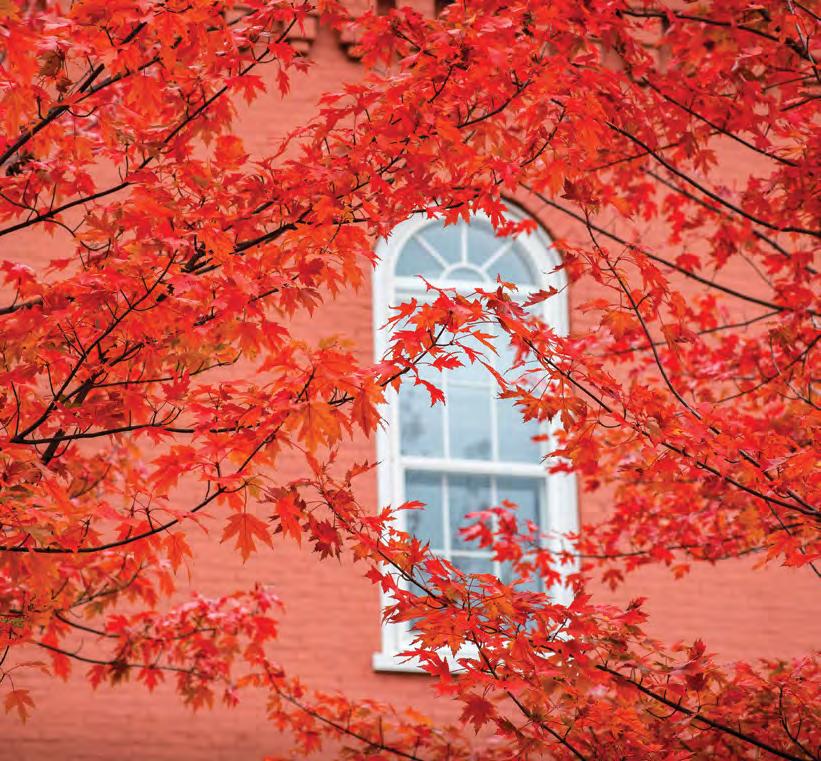
’11 Andrew Ian Gagnon, M.D.
Dr. Gagnon died on February 3, 2022 in a skiing accident in Solitude, Utah. He was 38, and was a transplant surgeon at Canyon Surgical Associates in Murray, Utah. He was born in Burlington, Vt., and
grew up in nearby Underhill. where he developed a love for soccer and the outdoors. He completed his undergraduate studies at Worcester Polytechnic Institute in 2005 before receiving his M.D. from UVM. He completed his medical residency in general surgery and fellowship in transplantation surgery at Lahey Hospital in Burlington, Mass. In 2018, he and his family moved to Utah, where he continued his career as a transplant surgeon at Intermountain Medical Center.
’17 Bryce M. Bludevich, M.D.
Dr. Bludevich died on June 25, 2022, at the McClure Miller Respite House in Williston, Vt. She was 32. Born at the Medical Center Hospital of Vermont, she was raised in Colchester. After graduating Phi Beta Kappa from Smith College, she lived in Cambridge, Mass., while working in a research lab at Boston Children’s Hospital. One of the happiest days of her life was when she was admitted to the Larner College of Medicine. While there, she actively participating in her class and other
College of Medicine activities and served as a 2017 class agent after graduation. Her interest in all things international led her to participate in the College of Medicine’s Global Health Program, with study and service in Russia and Uganda. She pursued a career in surgery and was matched with the surgical residency program at the University of Massachusetts Memorial Medical Center in Worcester, Mass. There she received the Resident Leadership Award in 2021 while enduring countless melanoma treatments. She is memorialized through the Bryce Bludevich Memorial Fund at the Larner College of Medicine, go.uvm.edu/bryce
In Memoriam
Willis E. Ingalls,
UVM LARNER COLLEGE OF MEDICINE 63
M.D.’64 Catherine Marie Yates, M.D.’95
Fall foliage outside Pomeroy Hall
Six Decades of Stories
Of the many notable records associated with the UVM Larner College of Medicine, one relates to the publication you are now reading. Vermont Medicine is quite likely the U.S. medical college magazine with the longest record of continuous publication.
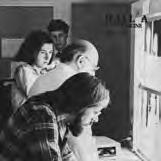
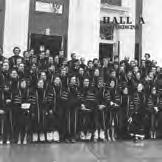
Founded in 1964 by the late John Mazuzan, M.D.’54, the magazine was known for its first 37 years as Hall A, after the
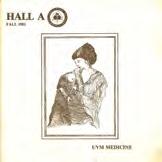
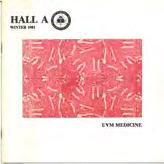
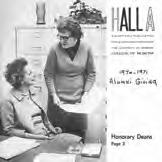
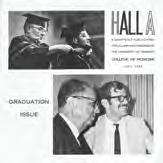
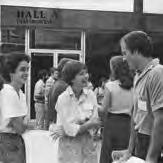
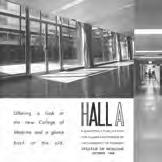
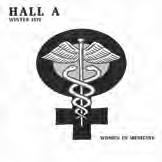
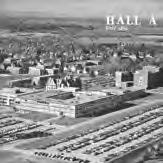
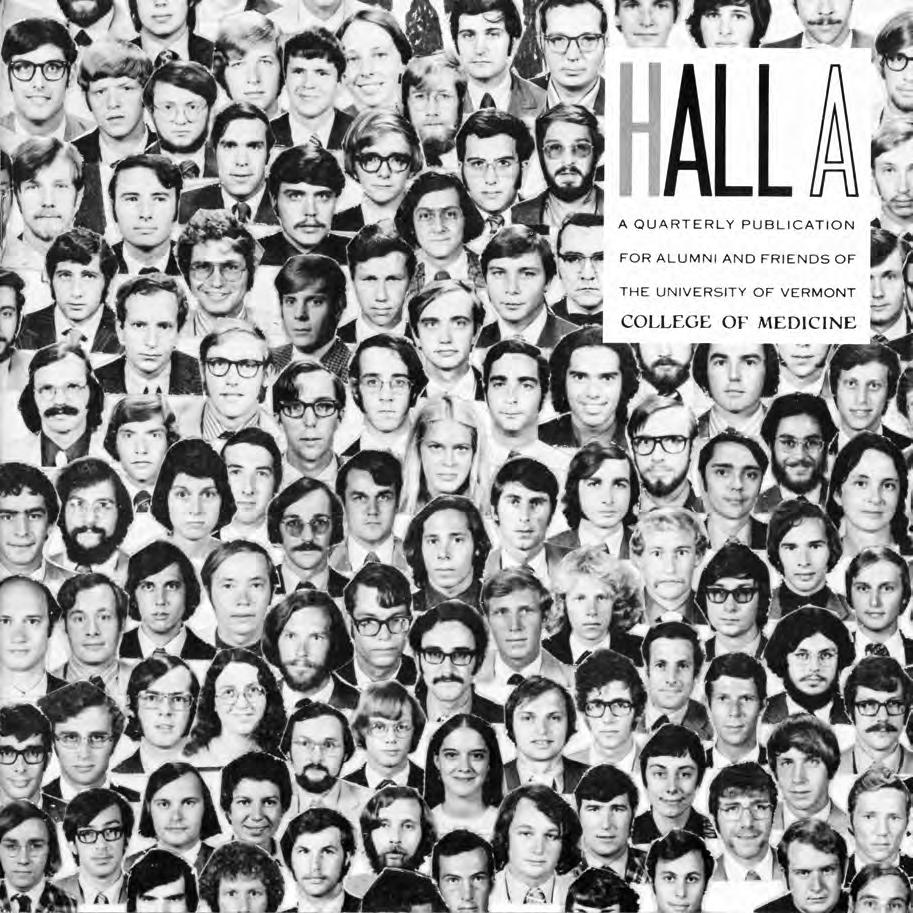
name of the main medical lecture hall at the old College of Medicine building on Pearl Street, and its successor space in the Given Building that existed until the early 2000s. In 2001 the magazine was renamed to maintain its relevance to new generations of students, as well as other community members on and off campus.
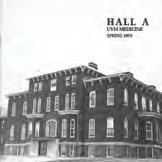
VERMONT MEDICINE FALL 202264
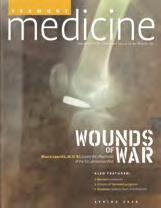
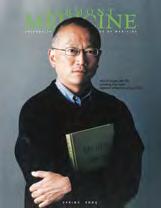
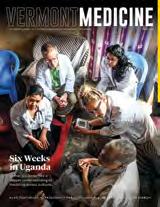
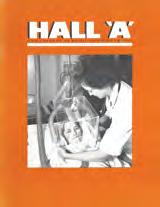
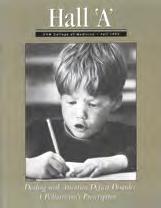
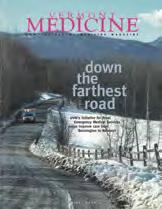
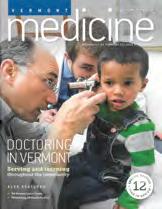
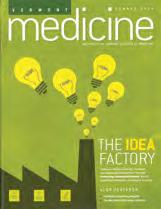
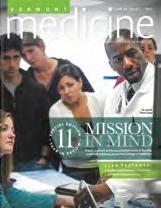
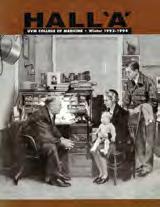
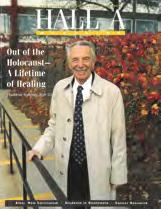
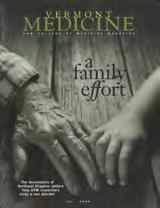
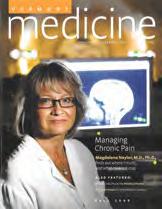
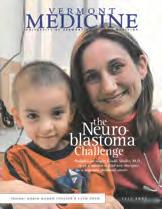
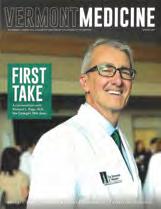
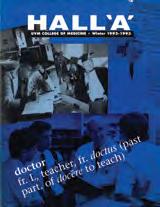
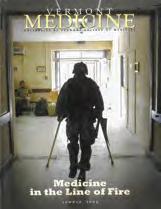
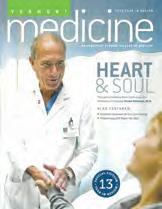
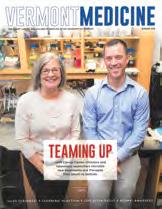
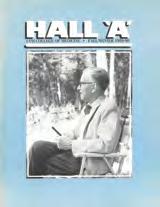
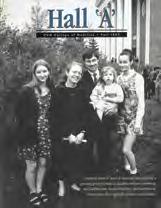
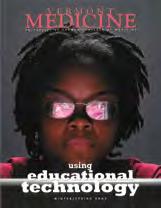
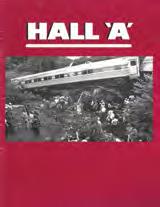
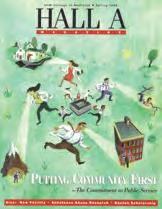
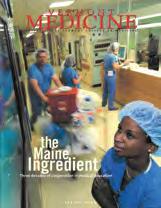
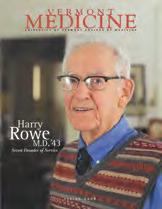
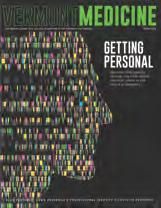
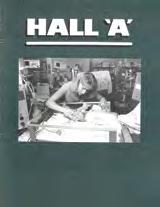
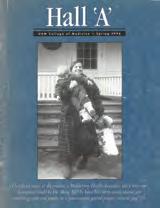
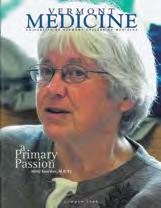
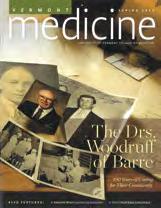
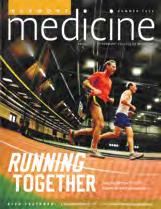
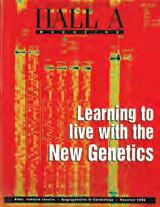
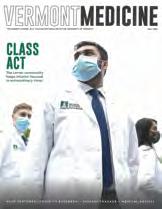
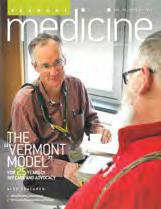
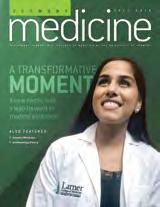
VERMONT MEDICINE
89 Beaumont Ave.
VT 05405
A special look at two centuries of medical education in Vermont
Non-Profit Org. U.S. POSTAGE PAID Burlington VT Permit No. 143
Burlington,
















































































 BY JANET ESSMAN FRANZ
BY JANET ESSMAN FRANZ





















































































